Past Seminars
2020
 Dr. Christopher Wirth (Assistant Professor, Chemical Engineering, Case Western Reserve University), host Bhuvnesh
Bharti
Dr. Christopher Wirth (Assistant Professor, Chemical Engineering, Case Western Reserve University), host Bhuvnesh
Bharti
Monday, January 27, 2020, 3:00 p.m., 1008B Digital Media Center
"Measuring the dynamics of colloidal particles with evanescent wave scattering"
ABSTRACT: Our lab is focused on developing experimental, computational, and theoretical techniques for the measurement and interpretation of the dynamics of complex or ‘anisotropic’ colloidal particles in confined geometries. This talk will summarize two vignettes from that work, namely (1) the development of Brownian dynamics simulations (BDS) to predict the probability density of states for anisotropic particles and (2) developing Scattering Morphology Resolved Total Internal Reflection Microscopy (SMR – TIRM) to directly measure such dynamics. First, we used BDS to predict the dynamics of a Janus particle very near a boundary. Data from these simulations were used to evaluate the influence of cap thickness and surface charge mismatch on the rotational dynamics of a single Janus particle very near a boundary. We found the presence of 5 nm - 20 nm thick gold caps had a profound effect on the rotational dynamics of particles with experimentally relevant sizes. Although Janus particles with a diameter less than 1 μm behaved as if they were isotropic, Janus particles with diameters larger than 1 μm experienced strong rotational quenching. This simulation tool was also utilized to develop methodology for computing the potential energy landscape from observations of position and orientation. In the second part of my talk, I will describe evanescent wave scattering mapping experiments conducted for the development of SMR - TIRM. Data from these mapping experiments on ellipsoidal particles show a strong dependence of the scattering morphology on both the particle orientation and shape. When combined with light scattering simulations from the T-matrix method, this morphology map will provide comprehensive information about the position and orientation of anisotropic particles near a boundary. Such information can be used to formulate the potential energy landscape of the particle, as shown by results from our BDS tool.
 Dr. Ziling (Ben) Xue (Professor, Chemistry, University of Tennessee, Knoxville), host Rongying Jin
Dr. Ziling (Ben) Xue (Professor, Chemistry, University of Tennessee, Knoxville), host Rongying Jin
Monday, February 3, 2020, 3:00 p.m., 1008B Digital Media Center
"Probing Molecular Magnetism by Neutron Scatterings"
ABSTRACT: Neutron with spin 1/2 has a magnetic moment. Neutron scatterings provide unique spectroscopic tools to study magnetism of chemical compounds.[1] Our recent work in using Inelastic Neutron Scattering (INS) and Quasielastic Neutron Scattering (QENS) to study metal complexes, especially single-molecule magnets (SMMs), will be discussed.[2-4] Zero-field splittings (ZFS) in d-metal complexes and intra-manifold separations in f-metal complexes lead to barriers for magnetic relaxations in SMMs. There are few techniques to directly determine large magnetic separations (>30 cm-1). We have successfully used INS to determine such large separations in several SMMs, including Co(acac-d7)2(D2O)2 (acac = acetylacetonate),[2] Co(14-crown-4)22+ [3] and Er[N(SiMe3)2]3 and compare them with those from optical spectroscopies such as far-IR and Raman.[3, 5] We have also used QENS to study methyl rotation in Co(acac)2(D2O)2 and how magnetic fields affect the molecular dynamics.[6]
[1] Z.-L. Xue et al., Eur. J. Inorg. Chem. 2019, 1065.
[2] S.E. Stavretis et al., Eur. J. Inorg. Chem. 2019, 1119.
[3] S.E. Stavretis et al., Chem. Eur. J. 2019, in press.
[4] L. Chen et al. Inorg. Chem. 2016, 55, 12603.
[5] D.H. Moseley et al., Nat. Commun. 2018, 9, 2572.
[6] S.E. Stavretis et al., Phys. Chem. Chem. Phys. 2018, 20, 21119.
 Dr. Elbio Dagotto (Distinguished Professor, Theoretical Condensed Matter Physics, University of Tennessee,
Knoxville), host Jiandi Zhang
Dr. Elbio Dagotto (Distinguished Professor, Theoretical Condensed Matter Physics, University of Tennessee,
Knoxville), host Jiandi Zhang
Monday, February 10, 2020, 3:00 p.m., 1008B Digital Media Center
"Study of multi-orbital Hubbard models in ladders and chains for iron-based superconductors and related compounds: emergence of orbital-selective Mott physics, block magnetic ordering, and pairing upon doping"
ABSTRACT: In this condensed matter seminar, I will review several results in the context of quasi one-dimensional systems, both ladders and chains, primarily in the context of iron-based superconductors. The recent discovery of superconductivity at high pressure in the two-leg ladder BaFe2X3 (X=Se,S) [1] established a new playground to better understand the pairing tendencies in these materials. For theorists the advantage is that many-body computational techniques are accurate in one dimension, even when using complicated multi-orbital Hubbard models. I will primarily focus on three concepts: (i) I will provide evidence that a new state -- dubbed orbital selective Mott phase -- is stable in a range of couplings. We found that in this state often exotic magnetic ``block’’, an even ``spiral’’, patterns develop [2,3]. Inelastic neutron scattering [4] confirmed some of our predictions, that include both acoustic and optical modes [5]; (ii) by studying Cooper pair formation and pair-pair correlations I will argue that spin-singlet superconducting tendencies can be observed in models for iron superconductors and also in two-orbital models that have the Haldane chain as a limit [6,7]; (iii) in the latter, the origin of spin-singlet pair formation can be explained involving orbital resonant valence bond variational states, similar to those used by Affleck et al. to explain the exotic properties of S=1 chains. Upon doping these states, spin singlet pairing clearly emerges [8].
This work was supported by the U.S. Department of Energy (DOE), Office of Science, Basic Energy Sciences (BES), Materials Sciences and Engineering Division.
[1] H. Takahashi et al., Nat. Mater. {\bf 14}, 1008 (2015), J. Ying et al., PRB 95,
241109(R) (2017).
[2] J. Rincon et al., Phys. Rev. Lett. {\bf 112}, 106405 (2014). See also Q. Luo et
al., Phys. Rev. B {\bf 87}, 024404 (2013).
[3] J. Herbrych et al., Phys. Rev. Lett. {\bf 123}, 027203 (2019) and references therein.
See also J. Herbrych et al., in preparation.
[4] M. Mourigal et al., Phys. Rev. Lett. {\bf 115}, 047401 (2015). See also M. Wang
et al., Phys. Rev. B {\bf 94}, 041111(R) (2016); J. M. Caron et al., Phys. Rev. B
{\bf 85}, 180405(R) (2012); J. M. Caron et al., Phys. Rev. B {\bf 84}, 180409 (R)
(2011).
[5] J. Herbrych et al., Nat. Comm. {\bf 9}, 3736 (2018).
[6] N. D. Patel et al., Phys. Rev. B {\bf 94}, 075119 (2016).
[7] N. D. Patel et al., Phys. Rev. B {\bf 96}, 024520 (2017).
[8] N. D. Patel et al., arXiv:2001.00589 (2020).
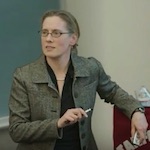 Dr. Sarah Keller (Professor, Chemistry, University of Washington), host Gerald Schneider
Dr. Sarah Keller (Professor, Chemistry, University of Washington), host Gerald Schneider
Friday, February 14, 2020, 12:30 p.m., 206 Williams Hall
"Phase separation in living cell membranes (and how curvature could make domains smaller)"
ABSTRACT: For decades, scientists have argued about the mechanisms of how living cell membranes acquire regions enriched in particular lipid and protein types. One highly contested theory has been that domains form via phase separation, as occurs in simple artificial membranes. This theory has been slow to gain acceptance because it contradicts the widespread assumption that inhomogeneities in living cell membranes are limited to sub-micron sizes (whereas phase separation results in much larger domains). Since the 1960s, researchers have reported tantalizing hints that membranes in yeast do indeed phase separate. However, proof of phase separation hinges on observation of a reversible phase transition. Here, we provide that direct evidence for vacuole membranes of living yeast cells. Inversely, when might unusually small domains appear in artificial membranes? Current theories of membrane microemulsions and modulated phases present several firm hypotheses, which we test in simple vesicle systems. In our system, small, stable domains are only observed in membranes with excess area.
 Dr. Jaehun Chun (Senior Research Scientist, Pacific Northwest National Laboratory), host Bhuvnesh
Bharti
Dr. Jaehun Chun (Senior Research Scientist, Pacific Northwest National Laboratory), host Bhuvnesh
Bharti
Monday, March 2, 2020, 3:00 p.m., 1008B Digital Media Center
"Colloidal dispersions: molecular details, forces, stability and rheology"
ABSTRACT: A colloidal dispersion has been a subject of interest in fundamental science and many practical applications such as emulsion polymerization, food, paints, spray dryers, and nuclear waste processing. A colloidal dispersion inherently involves a wide range of length scales and corresponding key physicochemical characteristics such as solution structures near solid/liquid interfaces, particle interactions, stability, and rheological responses. Interestingly, those characteristics are strongly coupled, and particle interactions often play as a bridge between such characteristics over different length scales. In this talk, we will explore the importance of physicochemical details (e.g., solvent structure/ion specificity and particle shape/surface roughness) in colloidal dispersions, combining experiments, theories, and simulations. This talk will clearly illustrate connecting scales is required to obtain in-depth understanding of various phenomena involved in colloidal dispersions.
2019
 Dr. Leah Broussard (Wigner Fellow, Oak Ridge National Laboratory), host Gerald Schneider
Dr. Leah Broussard (Wigner Fellow, Oak Ridge National Laboratory), host Gerald Schneider
Friday, January 18, 2019, 12:30 p.m, 206 Williams Hall
"The Nab Experiment: A Laboratory for Neutron Beta Decay"
ABSTRACT: The neutron has been recognized as an excellent target to search for new clues that can lead to an explanation for the lack of antimatter in the universe, insight on the nature of dark matter, and a more complete understanding of the laws and symmetries of nature. When removed from the nucleus, the free neutron is unstable, decaying with a lifetime of about 15 minutes. The kinematic properties of its decay provide a wealth of information about the weak force. The Nab experiment will provide one of the most precise tests of our understanding of the weak interaction by measuring correlations in unpolarized neutron beta decay. The experiment features a 7 m tall magnetic spectrometer that captures the electron and proton resulting from the decay, and silicon-detector based detection systems that allow reconstruction of the momenta of the decay particles. This presentation will introduce you to the unique features of the neutron and why it is important to particle physics, and describe how Nab, now commissioning at the Spallation Neutron Source at Oak Ridge National Laboratory, will study the properties of its decay with the best precision yet.
 Dr. Flora Meilleur (North Carolina State University/Oak Ridge National Laboratory), host Gerald Schneider
Dr. Flora Meilleur (North Carolina State University/Oak Ridge National Laboratory), host Gerald Schneider
Friday, February 8, 2019, 12:30 p.m., 206 Williams Hall
"Cellulose degrading oxidative enzymes: structural insights from neutron diffraction and scattering"
ABSTRACT: Sensitivity to hydrogen/deuterium and lack of observable radiation damage make cold neutrons an ideal probe for structural studies of redox enzymes. Neutron protein crystallography (NPC) is a powerful tool for investigating protein chemistry because it directly locates hydrogen atom positions [1,2]. Small-angle scattering (SAS) provides low resolution information on protein dimensions. Combined with contrast variation techniques and modeling, small angle neutron scattering (SANS) further allows the structural investigation of individual components within protein-protein complexes. I will first introduce the neutron facilities at ORNL before presenting recent results from my lab.
My lab focuses on metallo-enzymes with a specific interest in cellulose degrading oxidative enzymes. Fungal lytic polysaccharide monooxygenases (LPMOs) are copper containing metallo-enzymes involved in biomass oxidation. LPMO-catalyzed monooxygenation requires input of two electrons from LPMO redox partners, the cellobiose dehydrogenase enzymes (CDHs), and of one oxygen molecule to achieve hydroxylation of one carbon in the glycosidic bond [3]. I will discuss our recent X-ray and neutron crystallographic studies that provide new insight into the LPMO monooxygenation mechanism [4,5]. Redox complexes such as the LPMO-CDH complex, are often transient, and their structural characterization can be challenging. We are using SANS to characterize the interaction between CDH and LPMO [6].
 Dr. Jonathan Nickels (Assistant Professor, Chemical and Environmental Engineering, University of Cincinnati),
host Gerald Schneider
Dr. Jonathan Nickels (Assistant Professor, Chemical and Environmental Engineering, University of Cincinnati),
host Gerald Schneider
Monday, February 11, 2019, 3:00 pm, 1008B Digital Media Center
"Using neutron scattering to study nanoscale structure and motion in biomolecules"
ABSTRACT: Neutron scattering is a powerful technique for the characterization of biomolecules, providing unique information about the structure and dynamics of biological systems on multiple time and length scales. The sensitivity of the neutron to hydrogen and its isotope deuterium is a uniquely useful tool because of the abundance of hydrogen in biological materials, and draws a clear contrast to x-ray scattering methods in which there is only a weak sensitivity to hydrogen. Because of this, neutrons have proven useful in our research into the nature of water interactions with proteins and other biopolymers and into the properties of self-assembled lipid bilayers. In this discussion, I will focus on this latter project, specifically on how neutron scattering methods have helped to understand the physical basis of lateral lipid organization in cell membrane, covering my experiments with both model lipid bilayers and living cell membranes. The existence and role of lateral lipid organization in biological membranes has been studied and contested for more than 30 years. Lateral lipid domains, or rafts, are hypothesized as scalable compartments in biological membranes, providing appropriate physical environments to their resident membrane proteins. This implies that lateral lipid organization is associated with a range of biological functions, such as protein co-localization, membrane trafficking, and cell signaling, to name just a few. Moreover, we have recently suggested that lipid rafts may also act to buffer membrane physical properties from changes in temperature and environmental perturbations.
Our experiments have provided direct observations of cell membrane transverse and lateral structure in the Bacillus subtilis cell membrane. Neutron contrast from isotopic labeling was the key enabling tool to detect ~40nm lipid rafts via laterally heterogeneous distribution of labeled fatty acids. Using membrane mimics, we have also utilized other neutron to isolate the structure and dynamics of lipid domains in greater detail to interrogate potential mechanisms of raft formation. Finally, I will touch upon ongoing work which utilizes neutron scattering methods to demonstrate the proposed buffering effect of bilayer physical properties, suggesting a physically based function for these biological structures.
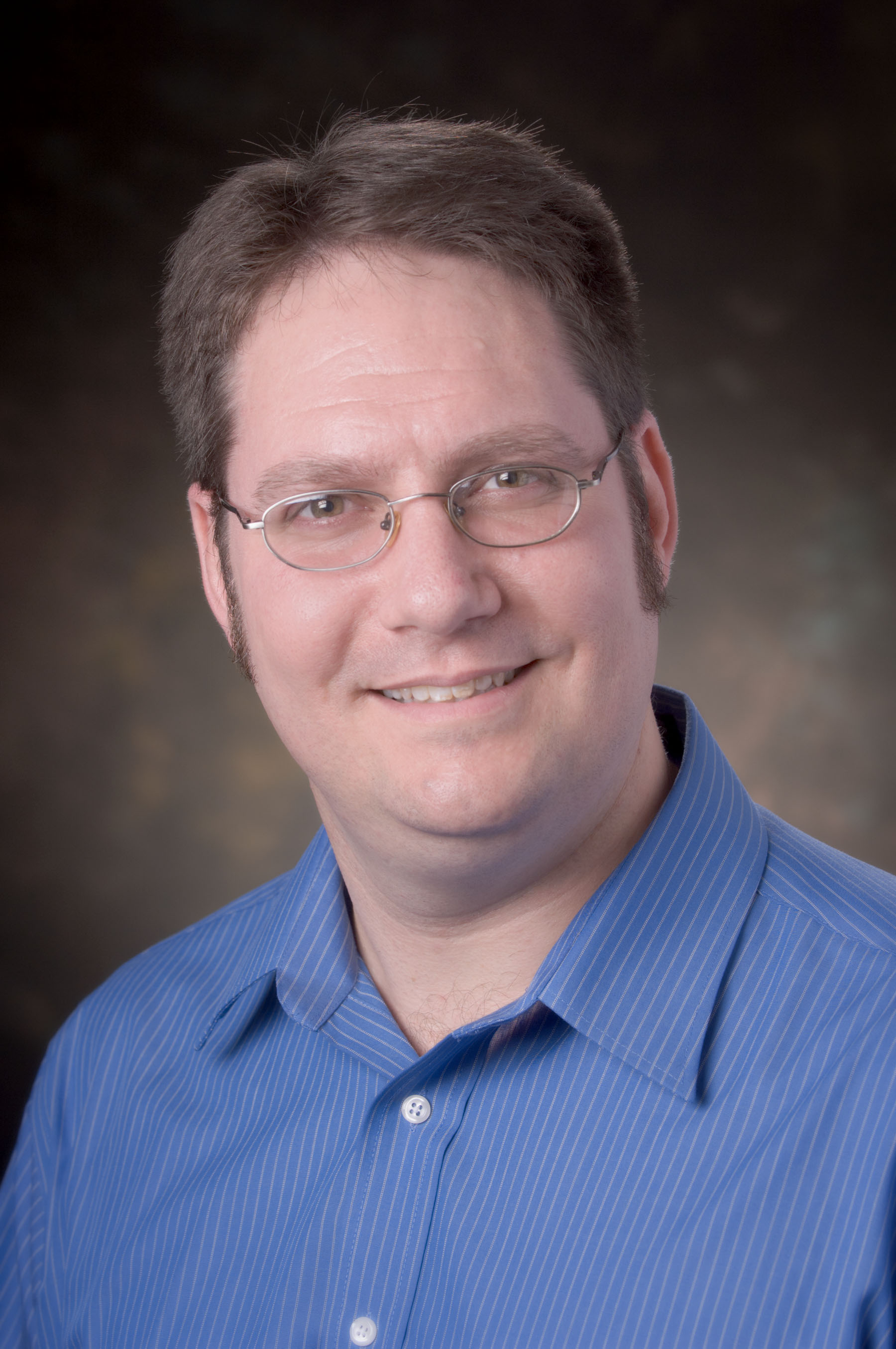 Dr. Eric Stinaff (Associate Professor, Physics and Astronomy, Ohio University), host Rongying Jin
Dr. Eric Stinaff (Associate Professor, Physics and Astronomy, Ohio University), host Rongying Jin
Monday, March 11, 2019, 3:00 p.m., 1008B Digital Media Center
"Opto-electronic studies of semiconductor nanostructures and 2D materials"
ABSTRACT: Our group investigates the optical and electronic properties of novel semiconductor nanomaterials, nanostructures and nanostructure-based devices. I will first present our work on quantum dots (QDs), nanoscale crystals whose dimensions are on the order of the size of the charge carriers (e.g. electrons). These have proven to be remarkably flexible tools for probing fundamental quantum mechanical properties and have received considerable attention as a candidate for physical implementations for quantum information processing. As individual QDs are brought together the discrete energy levels begin to display molecular behavior, forming bonding and antibonding orbitals. This new class of coupled nanostructures has already shown unique properties such as tunable g-factors and the formation of anti-bonding ground states. I will describe results from our research into these artificial molecules including optical studies of single spins, tunable luminescence lifetime effects, and the ability to control processes such as the electron-hole exchange interaction.
The second area of our research revolves around two-dimensional (2D) materials. We have developed a novel growth process based on the complementary growth of 2D semiconductors on, and around, bulk metal/metal-oxide patterns. This scalable process results in as-grown, naturally contacted, 2D materials-based devices. The technique has the added potential of producing self-contacted heterostructured devices as well as controllable doping of the 2D material using alloyed metallic contacts. The materials display strong luminescence, monolayer Raman signatures, and relatively large crystal domains. Measurements of first-generation metal-semiconductor-metal photodiodes, without any optimization and at standard temperature and pressure, typically show responsivities on the order of 1 to 10 A/W and a time response on the order of 2 µs, an order of magnitude faster than the best reported result. Since the material grows controllably around the lithographically defined patterns, complex device structures and wafer scale circuits can be envisioned.
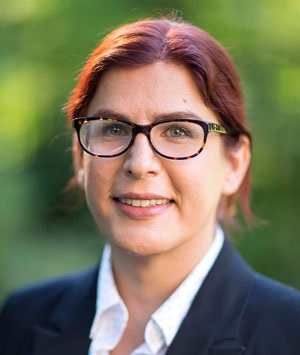 Dr. Lilo Pozzo (The Weyerhaeuser Endowed Associate Professor of Chemical Engineering, University
of Washington), host Bhuvnesh Bharti
Dr. Lilo Pozzo (The Weyerhaeuser Endowed Associate Professor of Chemical Engineering, University
of Washington), host Bhuvnesh Bharti
Monday, March 25, 2019, 3:00 p.m., 1008B Digital Media Center
"Structure and Dynamics of Conjugated Polymers from Neutron Scattering and MD Simulations"
ABSTRACT: Conjugated polymer films, nanofibers, and networks can be ideal materials for the design of efficient photovoltaic devices, batteries, thermoelectric cells, light emitting diodes and many emerging energy technologies. It is also recognized that the structure and dynamics of organic semiconductor materials correlates strongly with large changes in optical, electronic and mechanical properties so that their control and manipulation is essential to advancing the field. This presentation outlines the use of neutron scattering techniques in the development of structure-property relationships for conjugated polymer nanomaterials. It also highlights recent results on the use of neutron and x-ray scattering techniques for improvements in molecular simulation force fields specifically produced for conjugated polymers. Quasi-elastic neutron scattering (QENS) experiments are used along with computationally efficient MD simulations to understand the nature of important nanoscale motions. X-ray and polarized neutron diffraction are also used to correlate experimental and model-generated polymer structures. QENS validation of MD force fields presents a unique opportunity to increase the accuracy of highly uncertain parameters used in simulation of conjugated polymers and other complex macromolecules. These parameters are currently estimated from quantum mechanical calculations such as density functional theory but, unlike many force fields for small molecules, they are not parameterized to available experimental data. Moreover, high variability is observed in parameters for the small number of force fields that have been proposed in the literature.
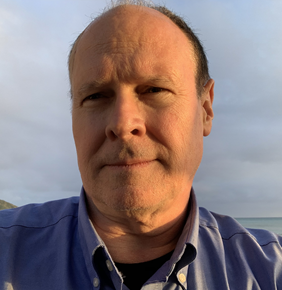 Dr. Ted Cremer (Chief Scientist, Adelphi Technology), host Leslie Butler
Dr. Ted Cremer (Chief Scientist, Adelphi Technology), host Leslie Butler
Tuesday, April 9, 2019, 3:00 p.m., 1008B Digital Media Center
“Fast and Moderated DD and DT Neutron Sources, Applications, and Neutron Optical Instruments”
ABSTRACT: Presented are fast (2.5 MeV DD and 14 MeV DT) fusion-based, Adelphi neutron generators and their applications, including Prompt Gamma Neutron Activation Analysis (PGNAA), radiographic-tomographic imaging, and 14 MeV DT-based Associated Particle Imaging (API), as well as a person-carried, field-deployable DT neutron generator, developed under a Defense Advanced Research Projects Agency (DARPA) grant.
Also presented are Adelphi moderated fast neutron sources, such as (1) epithermal neutrons for applications such as boron neutron capture therapy (BNCT) cancer treatment, and (2) thermal neutron sources for thermal neutron activation analysis (TNA), radiography-tomography, powder diffractometry, and residual stress analysis.
Briefly surveyed are slow neutron optics, including cold neutron spin echo devices, developed by the Pynn Group at Indiana University (commercialized by Adelphi), as well as Adelphi material (CRLs) and magnetic compound refractive lenses (MCRLs) for slow neutron microscopy, and compound refractive magnetic prisms (MCRPs) to offset gravity droop in small angle neutron scatter (SANS).
Presented are results of focusing and microscope-imaging experiments with MCRLs on pf2 VCN (very cold neutron) and D33 SANS (cold neutron) beam lines at Institüt Laue-Langevin (ILL) in Grenoble, France.
 Dr. Xi Dai (Professor, The Hong Kong University of Science and Technology), host Jiandi Zhang
Dr. Xi Dai (Professor, The Hong Kong University of Science and Technology), host Jiandi Zhang
Monday, April 29, 2019, 1:30 p.m., 1008B Digital Media Center
"Chiral magnetic effect and collective modes in topological semimetals"
ABSTRACT: Quasi-particles and collective modes are two fundamental aspects that characterize a quantum matter in addition to its ground state features. For example, the low energy physics for Fermi liquid phase in He-III was featured not only by Fermionic quasi-particles near the chemical potential, but also by fruitful collective modes in the long wave length limit, including several different sound waves that can propagate through it under different circumstances. On the other hand, it is very difficult for sound waves to be carried by the electron liquid in ordinary metals, due to the fact that long range Coulomb interaction among electrons will generate plasmon gap for ordinary electron density waves and thus prohibits the propagation of sound waves through the electron liquid. In the present paper, we propose a unique type of acoustic collective modes formed by Weyl fermions under the magnetic field, which is called chiral zero sound (CZS). The CZS only exists and propagates along an external magnetic field for Weyl semi-metal systems containing multiple-pairs of Weyl points. The sound velocity of CZS is proportional to the field strength in the weak field limit, whereas it oscillates dramatically in the strong field limit generating completely new mechanism for quantum oscillations through the dynamics of neutral Bosonic excitation, which may manifest itself in the thermal conductivity measurements under magnetic field.
Dr. Geoffrey Bothun (Professor, Chemical Engineering, University of Rhode Island), host Bhuvnesh Bharti
Monday, May 6, 2019, 3:00 p.m., 1008B Digital Media Center
"Lessons from nature: Engineered nanoparticles as proteins in lipid bilayers"
ABSTRACT: How engineered nanoparticles interact with biological membranes plays an important role in nanotoxicology and nanomedicine. These interactions can either stabilize or destabilize a membrane, which are comprised of a self-assembled lipid bilayer scaffold, depending on the size, shape, and surface chemistry of the nanoparticle. Proteins exhibit analogous behavior and are known to modulate membrane structure and function – this is involved in many cellular processes including endocytosis. Taking a lesson from nature, insight can be gained from our understanding of protein-membrane interactions to design nanoparticles with properties that allow us to control the membrane. For example, theories describing lateral capillarity and changes in lipid phase behavior caused by hydrophobic proteins may be extended to small hydrophobic nanoparticles embedded within lipid bilayers to control transmembrane permeability. Furthermore, if the nanoparticles are responsive to external electromagnetic fields, the structure and function of a membrane may be selected on demand. This seminar will describe collaborative work that has been ongoing in our group for over a decade to create a variety of “nature-inspired” hybrid liposome structures, as well as recent work using neutron scattering techniques to directly examine how nanoparticles alter the physical and mechanical properties of membranes.
 Dr. Grace Stokes (Clare Boothe Luce Assistant Professor, Chemistry & Biochemistry, Santa Clara University),
host Gerald Schneider
Dr. Grace Stokes (Clare Boothe Luce Assistant Professor, Chemistry & Biochemistry, Santa Clara University),
host Gerald Schneider
Friday, September 13, 2019, 12:30 p.m., Room 201 Williams Hall
"Quantifying Peptoid Adsorption to Phospholipid Membranes"
ABSTRACT: The Stokes Lab at Santa Clara University used second harmonic generation (SHG) to quantitatively describe adsorption of water-soluble N-substituted glycine oligomers (peptoids) to artificial lipid membranes. To advance the use of peptoids as therapeutics and coatings in biosensing applications, we elucidated the molecular-level forces that drive adsorption in order to predict how changes to sequence and 3D structure may alter membrane association. Artificial lipid membranes of varying phase, cholesterol content, and head group charge at a range of pH conditions represented lipids found in different tissue types. Our studies suggest that peptoids may adsorb to and perturb the physical structure of lipids in the mammalian plasma membrane. These non-specific interactions may impact bioaccumulation and toxicity and may also change the conformation and function of transmembrane proteins.
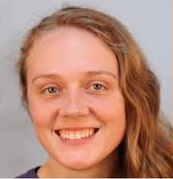 Dr. Margaret Scheiner (ORISE Program Manager, Oak Ridge Associated Universities), host Gerald Schneider
Dr. Margaret Scheiner (ORISE Program Manager, Oak Ridge Associated Universities), host Gerald Schneider
Friday, September 20, 2019, 12:30 p.m., 201 Williams Hall
"ORISE Internships – Federal Research Opportunities"
ABSTRACT: The Oak Ridge Institute for Science and Education (ORISE) is a U.S. Department of Energy asset that is dedicated to enabling critical scientific, research, and health initiatives of the department and its laboratory system. A major component of this is our efforts towards workforce development, including offering internships and scholarships to top students and researchers at all academic levels (https://orise.orau.gov/stem/internships-fellowships-research-opportunities/index.html). Currently open opportunities may be viewed through our Opportunity Catalog on Zintellect: https://www.zintellect.com/Catalog. Reflections from past ORISE participants are also available online: https://orise.orau.gov/stem/success-stories/index.html.
This talk will describe the types of research opportunities available to current college students (undergraduates and graduate students) and information on how to apply, including tips such as how to approach a potential mentor.
Dr. Margarita Fomina (Scientist, Oak Ridge Laboratory), host Gerald Schneider
Friday, October 4, 2019, 12:30 p.m., 201 Williams Hall
"Lipid droplets in yeast, animal, and human: biophysical insight"
ABSTRACT: All organisms store lipids for metabolic energy. Those lipids accumulate in the form of droplets inside cells. A lipid droplet is made of a hydrophobic lipid core surrounded by a phospholipid shell with associated proteins.
Surprisingly, in comparison with globular proteins, lipid droplets are rarely studied on the microscopic level, despite their vital importance in metabolism and energy storage. We investigated lipid droplets in vivo, revealing their physical properties and composition. Using quasi-elastic neutron scattering, the phase behavior and internal dynamics of lipid droplets affected by temperature were explored for the first time. Using mass spectrometry, the lipid composition of the droplets was obtained. The droplets’ size and volume were estimated via 3D microscopy. We compared the obtained characteristics of lipid droplets located in different types of cells (yeast, animal and human adipose [fat] tissues). As a model lipid system, we referred to a synthetic lipid vesicle.
Our investigation provided unique biophysical insight into natural, intact lipid systems in different organisms. This insight may elucidate the physical mechanisms governing fat cell necrosis induced by low temperatures during cryolipolysis (i.e., clinical treatment to reduce excess fat, or “fat freezing”). The analysis of yeast lipid droplets provided a basis for discussion of their energetic value in relation to their usefulness as biofuels.
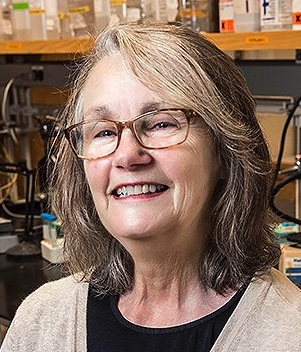 Dr. Mary F. Roberts (Professor, Chemistry, Boston College), host Gerald Schneider
Dr. Mary F. Roberts (Professor, Chemistry, Boston College), host Gerald Schneider
Friday, October 11, 2019, 12:30 p.m., 201 Williams Hall
"Field cycling 31P NMR relaxometry: A tool to identify novel phospholipid sites on peripheral membrane proteins"
ABSTRACT: Peripheral membrane proteins bind transiently to membranes. That binding is usually by an electrostatic interaction that drives the protein to the membrane followed by insertion of hydrophobic side chains into the membrane. Some proteins bind a specific phospholipid as a means of anchorage. Clearly, more than one lipid can interact with the protein. So how does one characterize specific multiple lipid binding sites for a transiently anchored protein? High resolution field cycling 31P NMR relaxometry (fc-P-NMR) is an experimental tool to address this question. Analysis of the magnetic field / angular frequency dependence of relaxation times can provide information on the dynamics of binding and the locations of specific binding sites, the latter aided by molecular modeling and MD simulations. Examples will include three enzymes: a bacterial phospholipase, the PH domain of Akt1, and the tumor suppressor PTEN. In each case, fc-P-NMR coupled with specific spin-labeling of the protein provides evidence for discrete phospholipid binding sites on the protein that were previously unknown.
 Dr. Zhi-Li Xiao (Argonne National Laboratory/Northern Illinois University), host Rongying Jin
Dr. Zhi-Li Xiao (Argonne National Laboratory/Northern Illinois University), host Rongying Jin
Monday, October 21, 2019, 3:00 p.m., 1008B Digital Media Center
"Frustration and crystallization in vortex matter tuned by artificial spin-ice"
ABSTRACT: Geometric frustration emerges when local interaction energies in an ordered lattice structure cannot be simultaneously minimized, resulting in a large number of degenerate states. The numerous degenerate configurations may lead to practical applications in microelectronics, such as data storage, memory and logic. However, it is difficult to achieve very high degeneracy, especially in a two-dimensional system. Here, we showcase in-situ controllable geometric frustration with high degeneracy in a two-dimensional vortex system. We create this in a superconducting thin film placed underneath a reconfigurable artificial-spin-ice structure [1]. The tunable magnetic charges in the artificial-spin-ice strongly interact with the vortices in the superconductor, enabling the switching between frustrated and crystallized vortex states. The different states have measurable effects on the superconducting critical current profile, which can be reconfigured by precise selection of the spin ice magnetic state through application of an external magnetic field. We demonstrate the applicability of these effects by realizing a reprogrammable vortex diode [2]. The tailoring of the energy landscape of interacting ‘particles’ using artificial-spin-ices provides a new paradigm for the design of geometric frustration, which could illuminate a path to control new functionalities in other material systems, such as magnetic skyrmions, electrons/holes in two-dimensional materials and topological insulators, as well as colloids in soft materials.
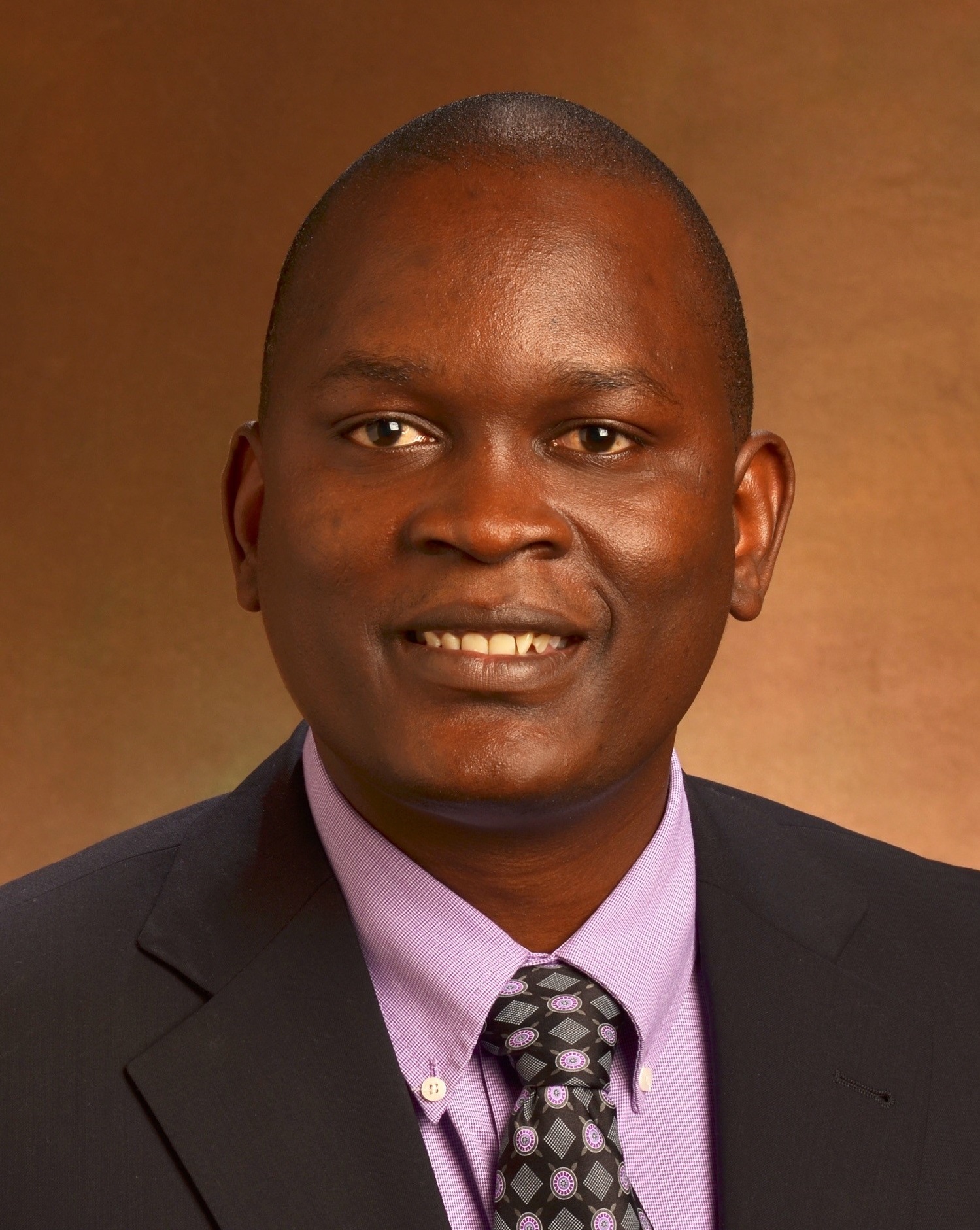 Dr. Joshua Sangoro (Assistant Professor, Chemical and Biomolecular Engineering, University of Tennessee,
Knoxville), host Gerald Schneider
Dr. Joshua Sangoro (Assistant Professor, Chemical and Biomolecular Engineering, University of Tennessee,
Knoxville), host Gerald Schneider
Friday, November 22, 2019, 12:30 p.m., 201 Williams Hall
"Mesoscale Organization and Dynamics in Ionic Liquids"
ABSTRACT: The impact of mesoscale organization on transport and dynamics in ionic liquids is investigated by broadband dielectric spectroscopy and dynamic mechanical spectroscopy as well as x-ray and neutron scattering techniques, complemented by computational approaches. Signatures of slow, sub-α dynamics are identified in the dynamic-mechanical and dielectric spectra and employed to probe lifetimes and dynamics of mesoscale aggregates in ionic liquids. It is found that the dynamics of mesoscale aggregates dominate many physicochemical properties such as the static dielectric permittivity and viscosity. By using mixtures of ionic liquids to tune composition-dependent evolution of the morphology, it becomes possible to realize ionic liquids with enhanced physicochemical properties that are otherwise inaccessible in neat systems. This talk will discuss the role of mesoscale organization and dynamics on macroscopic physical properties of ionic liquids.
 Dr. Mark Pederson (Program Manager, Computational and Theoretical Chemistry, DOE Office of Basic Energy
Sciences), host William Shelton
Dr. Mark Pederson (Program Manager, Computational and Theoretical Chemistry, DOE Office of Basic Energy
Sciences), host William Shelton
Monday, December 2, 2019, 3:00 p.m., 1008B Digital Media Center
"Molecular Magnets for Spectroscopic Sensing of Chemical Reactions and Qubits"
ABSTRACT: Early experimental investigations on spin-carrying metal centers, initially aimed at understanding how nature converts water to hydrogen and fixes nitrogen, formed the basis for the field of molecular magnetism 25 years ago. Shortly thereafter such molecules were postulated to be potentially realistic physical manifestations of spin-based qubits for quantum computers [1]. In this talk I will discuss computational and theoretical challenges associated with the accurate quantum-mechanical computational description of these systems and discuss two recent computer experiments that respectively: (A) show how a low-energy quantum-sensing technique can be used to deduce the chemical splitting of water into hydroxyl and hydrogen molecules [2] and (B) demonstrate how computational density-functional-based methods can be used to accurately determine the properties and complexities of putative molecular magnetic qubits that are composed of a perfect triangle of half-integer spin metal ions [3,4]. Connections to recent experimental publications will be made.
The Mn12O12(COOR)16(HOH)4 molecule, with S4 symmetry, has four of everything. Our recent calculations find that this system readily accepts four excess electrons at the cost of only 0.32 eV in vacuum. This molecule exhibits a macro-spin with S=10. It has received significant past interest due to the experimental observations and theoretically confirmed process of quantum tunneling of magnetization (QTM). Here, we show that the spectroscopic signatures associates with QTM are extremely sensitive to the presence of the four HOH terminators (e.g. 4 waters vs. 2H2 and 2OH) and to the number of added electrons (0 vs. 4). Our calculations suggest that QTM can be used as an ultra-low-energy non-destructive observation of water decomposition in a molecule with a core Mn4O4 unit that bears a striking similarity to the reaction center in the oxygen evolving complex. See Ref. 1.
Recently, Boudalis et al have experimentally observed the magneto-electric effect in a chiral Fe3O(NC5H5)3(O2CC6H5)6 molecule [5] and have noted further that this is the first possible spin-electric system based upon spin 5/2 metal centers. Our results [3], using standard density-functional methods, show that the spin-electric behavior of this molecule could be even more interesting as there are energetically competitive reference states with high and low local spins (S=5/2 vs. S=1/2) on the Fe3+ ions. We provide predictions of magnetic and x-ray spectroscopies to deduce the presence of both states. Possible uses for low-temperature quantum sensing of fields and pressure variations are suggested.
Recent efforts at improving standard approximations of density-functional theory using a new version of self-interaction-corrected DFT will be discussed within the context of this work [2,6].
2018
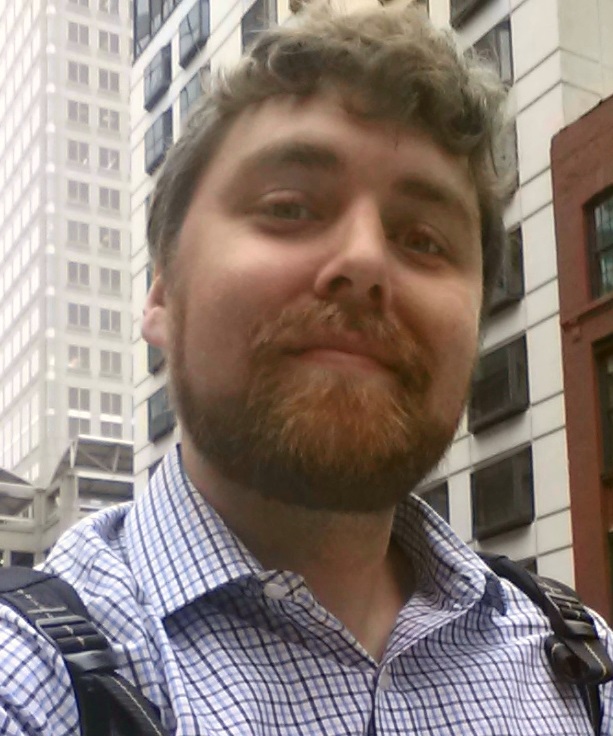 Dustin Gilbert
Dustin Gilbert
Monday, January 22, 2018, 3:00 pm, 1008B Digital Media Center
Dr. Gilbert is a Research Physicist at the NIST Center for Neutron Research
"Unique Uses of Neutrons in the Search for Magnetic Skyrmions"
ABSTRACT: Magnetic skyrmions exhibit topologically protected quantum states which offer exciting new mechanisms for ultrahigh density and low dissipation information storage and also provide an ideal platform for explorations of unique topological phenomena and magnetic quasiparticles. Neutron scattering has played a crucial role in the scientific investigation of skyrmions, including providing the first evidence of their discovery.[1] Here I will discuss two projects in which neutron scattering have been quintessential in advancing our understanding of skyrmion spin textures. In the first of these works we demonstrate the realization of artificial Bloch skyrmion lattices over extended areas in their ground state at room temperature and zero magnetic field.[2] These artificial skyrmion structures are generated by patterning vortex-state magnetic nanodots with controlled circularity on an underlayer film with perpendicular magnetic anisotropy (PMA). Key to this work was demonstrating the imprinting of the chiral skyrmion structure from the vortex into the underlayer film. The imprinted feature, buried underneath the nanodots, was directly probed by specular and off-specular polarized neutron reflectometry measurements. The neutron measurements proved to be intriguing in their own right as these structures are comparable to the neutron coherence length, and the off-specular reflectometry is a relatively rarely used technique.
In the second work we prepare a chiral jammed state in chemically disordered, B20 structured (Fe, Co)Si consisting of skyrmion lattices, multi-q helices and labyrinth domains. Using small angle neutron scattering (SANS) we demonstrate a symmetry-breaking magnetic field sequence which disentangles the jammed state, resulting in an ordered, oriented skyrmion lattice.[3] This sequence is independent of the initial orientation of the crystal, suggesting it could be applied to realize ordered lattices even in systems with overwhelming structural disorder such as powders. Indeed, ordered oriented skyrmion arrays are realized in powdered Cu2OSeO3 using the same sequence. Disentangling the jammed state changes the topological charge of the system and is accompanied by the nucleation of charged and un-charged magnetic monopoles. Micromagnetic simulations confirm the experimental results and suggest skyrmion-skyrmion interactions may be responsible for the observed ordering. Beyond the important physics of these results this approach makes the rapid screening of candidate skyrmion materials possible by allowing the measurement of powder samples.
 Vincent Meunier
Vincent Meunier
Monday, March 12, 2018, 3:00 pm, 1008B Digital Media Center
Prof. Meunier is the Gail and Jeffrey L. Kodosky ’70 Chair, Department of Physics, Applied Physics and Astronomy at Rensselaer Polytechnic Institute
“Breathe, shear, repeat…lattice vibration signatures of 2D materials"
ABSTRACT: 2D materials (2DMs) such as graphene, transition metal dichalcogenides (TMDs) and black phosphorus have attracted significant attention as emerging low-dimensional materials. These materials feature an array of properties that offer many promises in terms of potential electronic and optoelectronic applications. Many characterization techniques have been employed to improve the understanding of these materials, to establish their crystal structure, purity, number of layers, and internal arrangements. In particular, Raman spectroscopy, has demonstrated that the vibrations can be used as solid indicators of the structural properties of 2DMs. However, due to the emergence of new properties, the interpretation of experimental features requires a dedicated modeling effort based on quantum-mechanics. In this talk, I will overview how quantum mechanical properties and non-resonant Raman scattering are combined to determine the fundamental structural properties in a broad array of 2D materials. I will discuss the importance of low-frequency modes in the study of layer-layer interactions in 2DMs, and how relative twisting angles between layers can be determined by monitoring relative shifts in Raman active mode. I will also show how vibrational signatures can be exploited to understand in-plane anisotropy in phosphorene.
T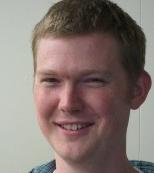 om Berlijn
om Berlijn
Monday, March 19, 2018, 3:00 pm, 1008B Digital Media Center
Dr. Berlijn is Research Staff at Oak Ridge National Laboratory
"Understanding Disordered Materials via Unbiased Simulations"
 ABSTRACT: Inserting disordered impurity atoms is one of the most powerful ways to
tune the functionality of advanced materials. In this talk I will demonstrate how
disorder controls and reveals the underlying physics of heat conductance in thermo-electrics,
electron pairing in superconductors and Anderson localization in intermediate band
semiconductors. In particular I will illustrate how unbiased and materials-specific
simulations shed light on complex experiments on disordered materials and allow for
a fundamental understanding of their properties.
ABSTRACT: Inserting disordered impurity atoms is one of the most powerful ways to
tune the functionality of advanced materials. In this talk I will demonstrate how
disorder controls and reveals the underlying physics of heat conductance in thermo-electrics,
electron pairing in superconductors and Anderson localization in intermediate band
semiconductors. In particular I will illustrate how unbiased and materials-specific
simulations shed light on complex experiments on disordered materials and allow for
a fundamental understanding of their properties.
 Srinivasa Raghavan
Srinivasa Raghavan
Monday, April 2, 2018, 3:00 pm, 1008B Digital Media Center
Dr. Raghavan is Professor and Patrick and Marguerite Sung Chair, Department of Chemical & Biomolecular Engineering at the University of Maryland
“Nature-Inspired 'Smart' Materials: Ability to Move, Morph, Destroy and Heal”
ABSTRACT: Our laboratory seeks to engineer the assembly of polymers, surfactants, and nanoparticles into micro- or nanostructured materials. We seek to create “smart” or responsive materials whose properties can be transformed by an external stimulus. The inspiration for our work frequently comes from nature, and extends across the range of length scales.
At the nanoscale, we study molecular self-assembly into structures such as vesicles and micelles. In addition, we have created self-assembling biopolymers that are able to convert liquid blood into a gel; thereby, the materials stop bleeding from serious injuries. A startup company is attempting to commercialize these “hemostatic” materials.
At the microscale, we create polymeric capsules inspired by the architecture and properties of biological cells. Examples include: capsules with many inner compartments; capsules that can “swim” in water in the presence of a chemical fuel; and capsules that can destroy other microscale structures.
At the macroscale, we are developing polymer hydrogels inspired by the responsive properties of plant leaves and aquatic creatures. For example, we have designed hydrogels that transform from a flat sheet to a folded tube in response to a specific cue. We have also designed hydrogel-membranes with the ability to regulate water flow based on temperature, pH, and light.
Miriam Siebenbürger
Monday, April 16, 2018, 3:00 pm, 1008B Digital Media Center
Dr. Siebenbürger is a Visiting Scholar at the Department of Polymer Science and Engineering, University of Massachusetts Amherst
"Mechanics of Colloidal Suspensions driven either by dynamics or by structure"
ABSTRACT: The colloidal scale, the size range between nanometer and micrometer, is a fascinating world of foams, emulsions and particles of any shape and of any type of materials. The applications reach from cosmetics and wall paint, to membranes and concrete. At the colloidal length scale, experimental methods of the millisecond to minutes range can be applied due to the slowdown of a factor of 109 of dynamics compared to molecular systems. Colloids are driven by Brownian motion and can be prepared in various shapes and surface properties. Colloidal suspensions can be used as a model system of utmost simplicity in order to compare it to theory: the hard-sphere suspension. The special focus of this talk is located on concentrated colloidal suspensions, their phase transitions from the fluid to the glassy or the crystalline state and structural changes resulting in enhanced mechanical properties. These fluid-to-solid transitions are characterized by the mechanics and flow properties with rheological approaches, the structure by scattering methods, and the combination of these techniques (here: rheology and small angle neutron scattering (rheo-SANS)).
The first part will focus on the dynamical arrest of a concentrated suspension resulting in the glassy state. Resulting rheological properties will be compared to the Mode Coupling Theory. This theory and its underlying mechanism will be confirmed by diverse rheological experiments. In combination with the theory, predictions of complex history dependent glassy mechanics are possible and can be transferred to other types of glasses.
The second part will focus on enhancing the mechanical properties by structural changes: the crystallization of colloidal suspensions and shear-aligning of crystals are followed by means of rheo-SANS and compared with simulations. Finally, neutron small angle scattering combined with cryo-TEM revealed the mechanism of the build-up of a very strong self-healing gel.
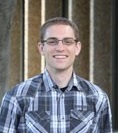 Marcel Baer
Marcel Baer
Monday, April 23, 2018, 3:00 pm, 1008B Digital Media Center
Dr. Baer is a Chemical Physics & Analysis Scientist at Pacific Northwest National Laboratory
“DFT and Force Field Study on the Effect of Ions on Structure and Side-Chain Interactions in Peptoids”
ABSTRACT: The description of peptides and the use of molecular dynamics simulations to refine structures and investigate the dynamics on an atomistic scale are well developed. A consensus in this community over multiple decades has resulted in the availability of parameterized force fields that only require the sequence of amino-acids and an initial guess for the three-dimensional structure. The recent discovery of peptoids, that are designed with functionality attached to the nitrogen instead of the Ca is a significant departure from the standard force fields for peptides and will require a retooling of the currently available interaction potentials in order to have the same level of confidence in the predicted structures and pathways as there is presently in the peptide counterparts. Here we present modeling of peptoids using a combination of ab initio molecular dynamics (AIMD), atomistic resolution classical FF and coarse-grained models (CG) to span the relevant time and length scales. To make contact with experiments and identify features of the peptoid monomers that promote formation of stable/ordered nanostructures, both nucleation and aggregation will be explored using CG simulations. To properly account for the dominant forces that stabilize ordered structures of peptoids, namely steric-, electrostatic, and hydrophobic interactions mediated through sidechain-sidechain interactions in the CG model those have to be first mapped out using high fidelity atomistic representations. A key feature here is not only to use gas phase quantum chemistry tools, but also account for solvation effects in the condensed phase through ab initio molecular dynamics simulation. One major challenge is to elucidate ion binding to charged or polar regions of the peptoid and its concomitant role in the creation of local order. Here, similar to proteins, a specific ion effect is observed suggesting that both the net charge and the precise chemical nature of the ion will need to be described.
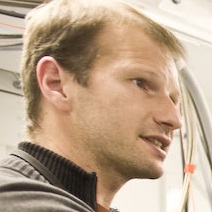 Thomas Weiss
Thomas Weiss
Thursday, May 3, 2018, 3:00 pm, 1008B Digital Media Center
Dr. Weiss is a Senior Research Engineer, Stanford Synchrotron Radiation Light Source, SLAC National Accelerator Laboratory
"Small-Angle X-ray Scattering and Its Application to Structural Molecular Biology"
ABSTRACT: Small angle X-ray scattering (SAXS) is a versatile and powerful tool to investigate the structure of matter on the nanometer scale. Its application especially in the field of structural biology has seen a tremendous growth over the last two decades and the technique has been well established as one of the main experimental tools for the structural biologist. While conceptually simple, the experimental realization is not trivial and typically requires a dedicated setup offering a highly collimated beam and extremely low residual background scattering. In addition, sophisticated sample handling and preparation is often necessary to perform these experiments error-free and efficiently in terms of sample consumption and beam time and obtain high quality data. The small-angle x-ray scattering station BL4-2 at the Stanford Synchrotron Radiation Light Source (SSRL) provides such state-of-the-art experimental facilities for biological SAXS studies. Over the past few years we have concentrated on developing and optimizing our instrument and sample handling equipment to save time and sample amount without compromising data quality. Examples are our fully automated high-throughput solution sample delivery robot, a highly automated size-exclusion chromatography coupled solution scattering setup (SEC-SAXS), as well as our customized stopped-flow device for reduced sample consumption to perform millisecond range time-resolved mixing experiments. In this presentation I will introduce the basics of the SAXS technique as they relate to structural studies of biological and soft matter systems, discuss several of the technical developments to facilitate the experiments at the synchrotron beam line and showcase some of the scientific work they enabled.
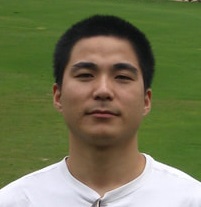 Jianwei Sun
Jianwei Sun
Monday, May 14, 2018, 3:00 pm, 1008B Digital Media Center
Dr. Sun is Assistant Professor, Physics and Engineering Physics, Tulane University
"The SCAN density functional and its surprising performance in cuprates"
ABSTRACT: The accuracy and computational efficiency of the widely used Kohn-Sham density functional theory (DFT) is limited by the approximation to its exchange-correlation energy Exc. The earliest local density approximation (LDA) overestimates the strengths of all bonds near equilibrium (even the vdW bonds). By adding the electron density gradient to model Exc, generalized gradient approximations (GGAs) generally soften the bonds to give robust and overall more accurate descriptions, except for the vdW interaction which is largely lost. Further improvement for covalent, ionic, and hydrogen bonds can be obtained by the computationally more expensive hybrid GGAs, which mix GGAs with the nonlocal exact exchange. Meta-GGAs are still semilocal in computation and thus efficient. Compared to GGAs, they add the kinetic energy density that enables them to recognize and accordingly treat different bonds, which no LDA or GGA can [2]. In this talk, I will present an advance in DFT, the recently developed non-empirical strongly constrained and appropriately normed (SCAN) meta-generalized gradient approximation (meta-GGA) [1]. SCAN predicts accurate geometries and energies of diversely-bonded molecules and materials (including covalent, metallic, ionic, hydrogen, and van der Waals bonds), significantly improving over its predecessors, the GGAs that dominate materials computation, at comparable efficiency [2]. SCAN’s excellent performance on cuprates, traditionally regarded as strongly-correlated systems out of reach of DFT, will be highlighted, exemplified by its accurate prediction of the metal insulator transition of La2CuO4 under doping [3]. I will further explain how SCAN was constructed [1], why it can improve over GGAs [2], and where it should fail [4]. At the end, efforts to improve SCAN via nonlocal corrections will be discussed.
[1] J. Sun, A. Ruzsinszky, and J.P. Perdew, Strongly constrained and appropriately
normed semilocal density functional, PRL 115, 036402 (2015).
[2] J. Sun, R.C. Remsing, Y. Zhang, Z. Sun, A. Ruzsinszky, H. Peng, Z. Yang, A. Paul,
U. Waghmare, X. Wu, M.L. Klein, and J.P. Perdew, Accurate First-principles structures
and energies of diversely-bonded systems from an efficient density functional, Nat.
Chem. 8, 831 (2016).
[3] J.W. Furness, Y. Zhang, C. Lane, I.G. Buda, B. Barbiellini, R.S. Markiewicz, A.
Bansil, and J. Sun, An accurate first-principles treatment of doping-dependent electronic
structure of high-temperature cuprate superconductors, Nature Communication Physics,
1, 11 (2018).
[4] H. Peng, Z. Yang, J.P. Perdew, and J. Sun, Versatile van der Waals density functional
based on a meta-generalized gradient approximation, PRX 6, 041005 (2016).
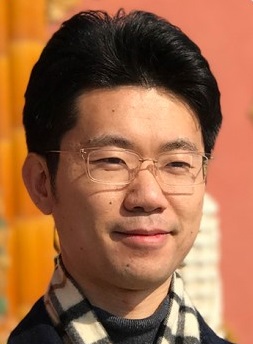 Hang Chi
Hang Chi
Monday, August 20, 2018, 3:00 pm, 1008B Digital Media Center
Dr. Chi is a Research Fellow, University of Michigan
"Transport properties of novel thermoelectric chalcogenides"
ABSTRACT: Thermoelectric materials can recover waste industrial heat and convert it to electricity as well as provide efficient local cooling of electronic devices. We first demonstrate that the efficiency (determined by the dimensionless figure-of-merit ZT) of such environmentally responsible and exceptionally reliable solid-state energy conversion can be enhanced through electronic band engineering in Mn-doped SnTe. Moreover, using thin film configurations, systematic study in Bi2Te3-based molecular beam epitaxial (MBE) films grown on sapphire (0001) and/or BaF2 (111) substrates, has revealed that the peak of phonon-drag thermopower can be tuned by the choice of substrates with different Debye temperatures. Finally, ZrTe5, known for large thermopower at cryogenic temperatures, has recently been revisited as a potential topological platform, hosting a highly anisotropic three-dimensional Dirac band. Transport measurements suggest the long-debated anomalous resistivity peak could be associated with a Lifshitz transition in the Dirac band. Such Lifshitz transition is readily controllable by means of doping. The anomaly peak temperature monotonically increases with the chemical potential, serving as an effective knob for fine tuning transport properties in pentatelluride-based Dirac semimetals.
 Ahmad Us Saleheen
Ahmad Us Saleheen
Monday, August 27, 2018, 3:00 pm, 1008B Digital Media Center
Ahmad is a PhD candidate, Department of Physics & Astronomy, Louisiana State University
"Magnetocaloric and barocaloric effects in (MnNiSi)1-x(FeCoGe)x"
ABSTRACT: Solid-state caloric effects, such as the magnetocaloric (MCE) and barocaloric (BCE) effects, may be utilized in future cooling technologies that are more efficient and environment-friendly. Large caloric effects often occur near phase transitions, especially near coupled first-order magnetostructural transitions (MST), and are initiated by external parameters, such as magnetic field or hydrostatic pressure. In this talk, the effects of pressure, temperature, and magnetic field on the phase transitions and associated caloric effects in a MnNiSi-based system will be discussed. MnNiSi undergoes a structural transition at about 1200 K, and a magnetic transition at TC = 662 K. Tuning these two transitions so that they coincide in temperature, produced a coupled MST which, in this case, was achieved through an isostructural alloying of MnNiSi with FeCoGe. The resulting coupled MST gave rise to a large conventional MCE near room temperature. Moreover, the MST was found to be extremely sensitive to applied hydrostatic pressure, which shifts the transition towards lower temperature at a rate of -7.5 K/kbar. Conversely, an applied magnetic field shifts the transition towards higher temperature. The strong pressure dependence along with a large volume change during the MST suggested the possibility of pressure-induced barocaloric effect (BCE) in this material. Subsequently, a large inverse BCE (i.e., the temperature decreases with increasing pressure) was observed through pressure-dependent calorimetric measurements. Through a purpose-built experimental setup, the temperature change due to the BCE was also measured directly, which was about -4.3 K for P = 2.5 kbar near room temperature. Since this material shows multiple caloric effects (MCE and BCE) at the same phase transition, it is considered to be a multicaloric material.
 Nitash Balsara
Nitash Balsara
Friday, September 21, 2018, 1:45 pm, 1253 Patrick F. Taylor Hall
Dr. Balsara is The Charles W. Tobias Professor in Electrochemistry, University of California Berkeley)
"Ohm's Law, Lithium Batteries, and the Clean Energy Landscape"
ABSTRACT: The need for creating safe electrolytes for lithium batteries is significant
given the continued safety problems associated with current lithium-ion
batteries. Nonflammable polymer electrolytes offer a possible solution but the rate
of lithium ion transport is too low for practical applications. In this talk, I will
discuss some of the fundamental factors that limit ion transport in polymers. Polymer
electrolytes obey Ohm’s Law, i.e. in the limit of small applied potentials, the current
generated at steady state is proportional to the applied potential. The underpinnings
of this observation, which remains to be established, will be discussed. The presentation
will discuss both homogeneous and nanostructured polymer electrolytes. The talk will conclude
with the relevance of these materials in the emerging clean energy landscape.
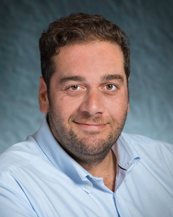 Michalis Charilaou
Michalis Charilaou
Monday, October 1, 2018, 3:00 pm, 1008B Digital Media Center
Dr. Charilaou is an Assistant Professor, Department of Physics, University of Louisiana at Lafayette
"Dynamic monopoles in ferromagnetic nanoparticles"
ABSTRACT: The competition between different magnetic forces at the nano-scale gives rise to unexpected phenomena. When the size of ferromagnetic nanoparticles becomes comparable to the fundamental magnetic length scales, topological constraints play a crucial role in the magnetization process, and a reversal cannot be completed by the well-known curling instability without violating topological constraints [1]. Irreversibility is closely associated with a change in the topology of the magnetic texture in ferromagnetic particles. Specifically, full magnetization reversal can only be achieved by the pair-creation of topological point defects, otherwise known as hedgehogs or Bloch points. These defects move rapidly through the solid and generate emergent electric fields with solenoidal character, in analogy to the magnetic field generated by a moving electric charge (shown in the figure to the right, taken from [1]). The solenoidal character of the emergent fields highlights the monopole nature of the defects. Importantly, these defects move with unprecedented speeds in excess of 1000 m/s, faster than any other known magnetic object, and the emergent fields have a magnitude on the order of megavolts per meter, comparable to the dielectric breakdown in vacuum. These results emphasize the importance of topological arguments in magnetic systems and support possible applications with dynamic emergent fields.
[1] M. Charilaou, H. B. Braun, J. F. Löffler: Monopole-Induced Emergent Electric Fields in Ferromagnetic Nanowires. Physical Review Letters 121, 097202 (2018).
 Despina Louca
Despina Louca
Monday, October 8, 2018, 3:00 pm, 1008B Digital Media Center
Dr. Louca is a Professor, Experimental Condensed Matter Physics, University of Virginia
"Elastic and Electronic Tuning of Magnetoresistance in MoTe2"
ABSTRACT: The transition metal dichalcogenide (TMD) semiconductors exhibit many versatile physical features and have become a new paradigm for optoelectronic applications, based on exfoliated single layer molecular structures. Fueled by intense interest on new device concepts, TMDs provide a platform from which optoelectronic properties such as spin-valley coupled physics and two-dimensional valley excitons can be pursued. They have a desirable optical band gap in the 1-2 eV energy range, important for visible and near-infrared technologies. Manipulation of the band gap either by reducing the sample thickness down to a monolayer or applications of strain can lead to distinct changes in their physical characteristics.
The observation of an extremely large magnetoresistance (MR) in the layered TMDs of WTe₂ and MoTe₂ has led to a surge of interest in this field. The layered crystal structure consists of strong in-plane covalent bonding and weaker van der Waals type interactions between planes. MoTe₂ in particular can exist in several crystal configurations that includes the high temperature 2H, the intermediate temperature 1T' and the low temperature Td structures. β-MoTe₂ (1T') is metastable at room temperature and is metallic with a monoclinic (P2₁/m) structure. Upon cooling from room temperature, an anomaly appears in the transport data around 240 K that has been linked to a first order structural transition from the 1T' of β-MoTe₂ to the orthorhombic Td phase (Pmn2₁). The Td phase exhibits the extreme MR effect and the host of a Weyl semimetal state, a new state of matter in which collective excitations known as Weyl fermions may exist. It has been suggested that the band structure of MoTe₂ is highly sensitive even to small changes in the lattice constants either brought upon by strain or as a function of temperature.
The anomalously large MR observed under high magnetic fields in MoTe₂ can be reversibly controlled under tensile strain. The MR is enhanced by as much as ∼ 30 % at low temperatures and high magnetic fields, when uniaxial strain is applied along the a-crystallographic direction and reduced by the same amount when strain is applied along the b-direction. The large in-plane electronic anisotropy sets in at the transition from the 1T' monoclinic to the Td orthorhombic Weyl phase. Ab-initio calculations of the electronic structure under strain show a comparable change in the electron cyclotron mass closely related to the MR under high magnetic field. The sensitivity of the cyclotron mass to tensile strain could have its origin to the presence of Weyl points between electron and hole pockets.
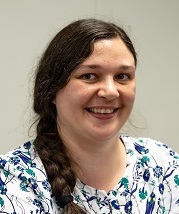 Miriam Siebenbürger
Miriam Siebenbürger
Friday, October 19, 2018, 3:30 pm, Life Sciences Annex Auditorium (A-101)
Dr. Siebenbürger is a Research Associate, LSU Center for Advanced Microstructures and Devices
"Metastable states of colloidal suspensions: Influence of interactions and packing density on structure and dynamics"
 Susan Kauzlarich
Susan Kauzlarich
Thursday, October 25, 2018, 3:00 pm, 1008B Digital Media Center
Dr. Kauzlarich is a Distinguished Professor of Chemistry, University of California Davis
"Applications of Zintl Phases for Direct Thermal to Electrical Energy"
ABSTRACT: There are many areas of science where progress is materials limited. The synthesis and identification of new compounds that can lead to enhancements in existing technologies, or serve as the basis of revolutionary new technologies, is essential for developing new and improved technologies. Zintl compounds can be described by a combination of ionic and covalent bonding, composed of electropositive cations which donate electrons to the more electronegative components that utilize the electrons to form various bonding motifs. My group has focused on Zintl compounds for their structural, chemical, and electronic properties and I will present research on Zintl phases for thermoelectric applications such as waste heat to electrical power conversion.
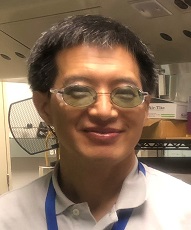 Kunlun Hong
Kunlun Hong
Monday, October 29, 2018, 3:00 pm, 1008B Digital Media Center
Dr. Hong is Senior Research Staff, Oak Ridge National Laboratory
"Block Copolymers Containing Conjugated Blocks: Controlled Synthesis and Optical Properties"
ABSTRACT: The optical, electronic, and mechanical properties of polymeric materials depend critically on their chain conformations. For example, flexible polymers usually adopt highly disordered conformations resembling a random coil. On the other hand, stiff polymers (such as conjugated polymers) are expected to collapse into conformations with long-range order owing to their strong intrachain interactions. Conjugated polymers are attracting a lot of attention because of their potential applications for organic electronics. However, these polymers have not achieved their full potential in such applications mainly because of difficulties in controlling their self-assembly behaviors. Moreover, the solution behaviors of conjugated polymers are far from understood. In this presentation, I will discuss our recent results for synthesis of different conjugated polymers through controlled polymerizations including various cross-coupling reactions, and substrate-assisted polymerizations. Particular attention is focused on the impact of the structural variations on their solution behavior, optoelectronic properties resulting from assembly in solutions and in thin films.
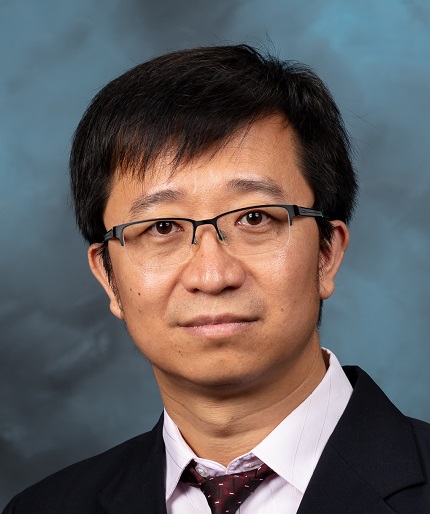 Huibo Cao
Huibo Cao
Tuesday, October 30, 2018, 3:00 pm, 1008B Digital Media Center
Dr. Cao is an Instrument Scientist, Oak Ridge National Laboratory
"Giant spin-lattice coupling in a paraelectric antiferromagnet EuTiO3 studied by neutron scattering"
ABSTRACT: Mutual control and detection of magnetic and electric orders are of great interest in many fields for their applications in novel devices and therefore have attracted long period attentions. However, in most cases, magnetic and electric orders either have largely different energy scales or weakly coupled. Giant spin-lattice coupling in EuTiO3 was first revealed by Katsufuji and Takagi in 2001. The dielectric constant in EuTiO3 shows a significant change at the magnetic ordering temperature and also responds to a magnetic field. Incipient ferroelectricity was expected for EuTiO3 for its plenty of similarities to SrTiO3 and it has the same energy level as the magnetic order. The discovery of ferroelectric ferromagnet in its film matter further excited the attentions in EuTiO3. In this talk I will introduce the neutron scattering work on the isotope 153EuTiO3 crystal. Taking the advantages of neutron scatterings in terms of detecting phonons, magnons, and their couplings, we have discovered a “flat” hybrid phonon-magnon mode at ~ 10 meV at temperature below ~ 100 K, which interacts with the soft ferroelectric transvers optical phonon (TO) mode at low temperature and repulses the TO mode to higher energy. Our results reveal the hidden mechanism of spin-lattice coupling in EuTiO3 and for the first time shows a hybrid phonon-magnon mode that survives at above the magnetic ordering temperature. The polarized neutron diffraction further confirms that 3d-4f orbital hybridization makes an important role in strong spin-lattice coupling in EuTiO3.
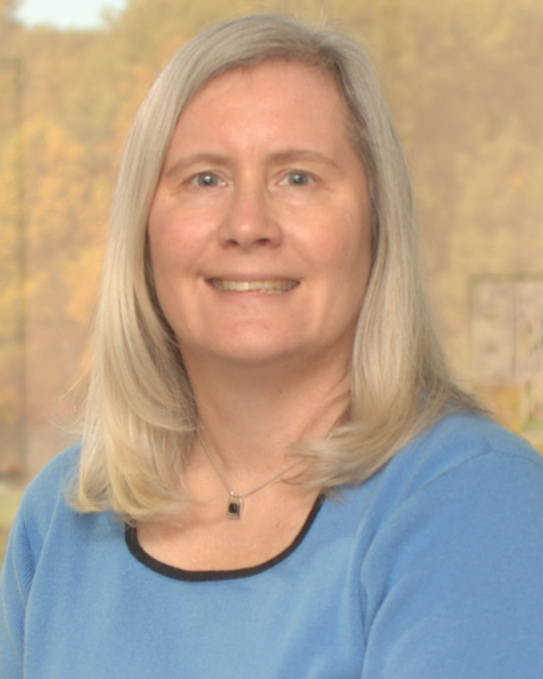 Susan Krueger
Susan Krueger
Monday, November 5, 2018, 3:00 pm, 1008B Digital Media Center
Dr. Krueger is a Research Physicist, NIST Center for Neutron Research
"Structure and Function of Biological Macromolecules in Solution: The Unique Role of Small-Angle Neutron Scattering"
ABSTRACT: Small-angle neutron scattering (SANS) is a useful tool for investigating the structure of complex biological macromolecules in solution. Neutrons are sensitive to the positions of the light elements such as hydrogen, carbon, nitrogen and oxygen, which are of central importance to all biological systems. They are also sensitive to different isotopes, especially hydrogen and deuterium. SANS takes advantage of these properties to provide unique insight into macromolecular structure and function through a technique known as contrast variation. The scattering from one component in a biological complex can be separated from that of the others, providing unique structural information about each component individually, as it is interacting with the others in the complex. The concept of SANS from biological macromolecules in the dilute limit will be introduced, focusing on the use of deuterium labeling, contrast variation and all-atom structure modeling to determine the structure of the individual components in protein-nucleic acid, protein-lipid and protein-protein complexes. More advanced topics such as concentrated solutions and extreme environmental conditions will also be mentioned.
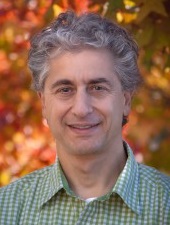 John Katsaras
John Katsaras
Monday, November 12, 2018, 3:00 pm, 1008B Digital Media Center
Dr. Katsaras is a Senior Scientist, ORNL Large Scale Structures Neutron Sciences Directorate
"Static and Dynamic Neutron Scattering Studies of Biologically Relevant Membranes"
ABSTRACT: Biomembranes are the active boundary between cells and their surroundings. They are sophisticated and dynamic machines that perform a diverse array of functions, including selective transport, localization, communication and recognition, to name a few. It is also widely accepted that the plasma membrane is laterally heterogeneous containing nanoscopic regions enriched in certain types of lipids, which have different physical properties from the surrounding lipids. These functional lipid domains in biology are commonly referred to as “rafts”. Rafts have been implicated in a wide range of cellular functions, including signal transduction, drug uptake, and interactions with pathogens. In recent years, we have used small angle neutron scattering (SANS) and neutron spin echo (NSE) to study nanoscopic lipid domains in model membrane systems [1-3] and more recently, in the Gram-positive bacterium Bacillus subtilis in which the first ever observation of lipid domains was made [4]. The seminar will conclude with future directions of potential interest to biophysicists and biologists.
[1] F. A. Heberle, R. S. Petruzielo, J. Pan, P. Drazba, N. Kučerka, R. F. Standaert,
G. W. Feigenson, J. Katsaras, J. Am. Chem. Soc. 135, 6853 (2013).
[2] F. A. Heberle, M. Doktorova, S.-L. Goh, R. F. Standaert, J. Katsaras, G. W. Feigenson,
J. Am. Chem. Soc. 135, 14932 (2013).
[3] J. D. Nickels et al., J. Am. Chem. Soc. 137, 15772 (2015).
[4] J. D. Nickels et al., PLoS Biology 15, e2002214 (2017).
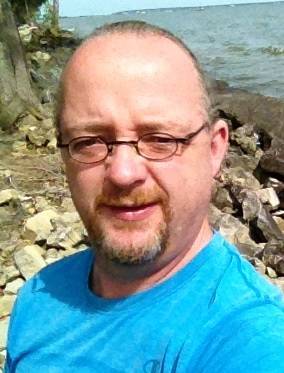 Markus Bleuel
Markus Bleuel
Monday, November 19, 2018, 3:00 pm, 1008B Digital Media Center
Dr. Bleuel is a research scientist at NIST Center for Neutron Research
“Sample Environments for Time Modulation at Small Angle Neutron Scattering (SANS) Experiments”
ABSTRACT: This presentation shows examples for SANS sample environments targeting slow dynamics of nanostructures under development at the National Center for Neutron Research (NCNR) at NIST, MD. It aims to stimulate discussions and possibly collaborations for future research projects, exploring the question what are the limits and time scales available and needed for example in experiments with modulated E-, B-fields or dynamic pressures using a PIEZO crystals or ultrasonic transducers.
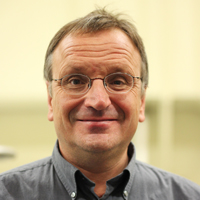 John Singleton
John Singleton
Monday, November 26, 2018, 3:00 pm, 1008B Digital Media Center
Dr. Singleton is an ANL Fellow, Los Alamos National Laboratory/National High Magnetic Field Laboratory
"Magnetic quantum oscillations in fields of up to 101 T, and their application to alloys, superconductors and heavy-fermion systems"
ABSTRACT: Magnetic quantum oscillations (MQOs) occur in any material with a closed Fermi surface subjected to high enough magnetic fields. Perhaps the best-known example of this phenomenon is the de Haas-van Alphen effect, valuable because the oscillations occur in a thermodynamic function of state - the magnetization - and so can be related to theoretical models with few or no assumptions. However, it is often more convenient to measure the resistance of a sample, and so Shubnikov-de Haas oscillations of the electrical conductivity are frequently studied. This talk will describe how these MQOs can be observed in samples subjected to pulsed magnetic fields of up to 101 T. Such extreme conditions demand unusual techniques; for example, to observe Shubnikov-de Haas oscillations, we often measure the sample's skin depth at MHz frequencies. At such high fields, the MQOs do not just reveal the Fermi surface's three-dimensional shape (the classic textbook application); they also allow other fundamental quantum-mechanical energies of the system to be probed, and nanometre-scale microstructure to be studied.
To illustrate these ideas, I will describe three examples. (i) In the heavy-fermion topological semimetal CeOs4Sb12, the MQOs allow the mechanism behind a bizarrely curved phase boundary in the field-temperature plane to be deduced. (ii) Shape-memory alloys are used in many technological applications, including spectacle frames and underwired bras; de Haas-van Alphen oscillations show that the shape-memory transition is electronically driven and reveal the resulting microstructure deep inside the sample without recourse to cutting or polishing. (iii) Even though the superconductor AuBe is only available in polycrystalline samples, MQOs - normally requiring a single crystal - reveal its Fermi surface and the unusual properties of some of its electrons that behave as though they are hyper-relativistic.
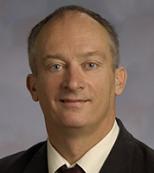 Jeremy Smith
Jeremy Smith
Friday, November 30, 2018, 3:30 pm, Life Sciences Annex Auditorium (A-101)
Dr. Smith is Director, ORNL Center for Molecular Biophysics
"Neutron Scattering and Drug Discovery"
ABSTRACT: Neutron scattering, when combined with computational science, can aid in the drug discovery process in several ways. We illustrate how precision neutron crystallography can permit the derivation of the thermodynamic driving forces behind the binding of drugs to their targets. Also, we show how computational drug design protocols benefit considerably from a dynamic, rather than just a static, description of the protein to be modulated. We describe how small-angle and dynamic neutron scattering, when combined with computer simulation, provide useful information on the motions involved. We show that motions in single protein molecules are complex, being non-ergodic and non-equilibrium, and exhibit ageing, these properties arising from the fractal nature of the topology and geometry of the energy landscape explored. We describe how taking these motions into account in supercomputer-based virtual high-throughput screening has led to the discovery of lead compounds for a variety of diseases.
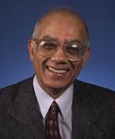 Sunil Sinha
Sunil Sinha
Monday, December 10, 2018, 3:00 pm, 1008B Digital Media Center
Dr. Sinha is a Distinguished Professor of Physics, University of California San Diego
"Studies of Dynamics of Soft Matter using Coherent X-Ray Scattering"
ABSTRACT: The dynamics of thin polymer films can be probed by studying the relaxation of surface capillary wave fluctuations using the technique of X-ray Photon Correlation Spectroscopy. This is the X-ray analog of Dynamical Light Scattering and utilizes beams of coherent X-rays available from modern synchrotron X-ray sources. We shall review the method and some of the results obtained, including the limits of validity of simple hydrodynamic fluid theory, the behavior of very thin polymer films, what happens as the glass transition is approached, and the study of the entangled dynamics of nanoparticles inserted into polymer films. We will also briefly discuss some recent applications of Soft X-Ray Resonant Magnetic Scattering to study phase transitions in frustrated spin systems.
Sunil Sinha
Tuesday, December 11, 2018, 10:00 am, 435 Nicholson Hall
"Studies of Phase Separation in Mixed Lipid Systems"
ABSTRACT: The "raft hypothesis" of biological membranes, first advanced now more than two decades ago, continues to invoke considerable debate and controversy. Its central claim has been that the lipid bilayer in cellular membranes is not an unstructured solvent; rather it is chemically textured, consisting of phase-separated domains enriched in saturated lipids, cholesterol, sphingolipids, and certain integral membrane proteins. This has spurred numerous investigations of phase separation behavior in simpler model mixed lipid systems, consisting of saturated and unsaturated lipids with cholesterol.
X-ray and neutron lamellar diffraction methods applied to lipid multilayers have been well-established and demonstrated as powerful techniques to quantitatively study the detailed lipid bilayer structures. We shall discuss some recent results we have obtained on the structure, composition and the cholesterol positional distribution of phase separated multilamellar smectic phases of these mixed lipid systems in varying relative humidity. This includes some recent resonant soft X-ray small angle scattering studies of ordered subdomains in the phase separated structures and the preferential ordering of gold nanoparticles in these domains.
2017
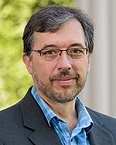 Norman Wagner
Norman Wagner
Monday, November 20, 2017, 3:00 pm, 1008B Digital Media Center
Dr. Wagner is a Robert L. Pigford Chaired Professor of Chemical & Biomolecular Engineering at the University of Delaware, Newark
"The micromechanics of shear thickening fluids and their application as protective materials for medical professionals, first responders, football players, astronauts and spacecraft"
ABSTRACT: Shear thickening colloidal and/or nanoparticle suspensions are commonly encountered in chemical and materials processing, and are also the basis of a technology platform for advanced, field responsive nanocomposites. In this presentation, I will review some of the experimental methods and key results concerning the micromechanics of colloidal suspension rheology. Micromechanics is the ability to predict the properties of complex systems from a colloidal or microscopic level description of the structure and forces. A fundamental understanding of colloidal suspension rheology and in particular, shear thickening, has been achieved through a combination of model system synthesis, rheological, rheo-optical and rheo-small angle neutron scattering (SANS) measurements, as well as simulation and theory (Colloidal Suspension Rheology, Mewis and Wagner, Cambridge Univ. Press, 2012).
Shear thickening fluids (STFs) are novel field-responsive materials that can be engineered to be useful nanocomposites for enhanced ballistic and impact protection, puncture resistant medical gloves, energy absorbing materials for mitigating impacts and concussions, as well as in systems for mitigating micrometeoroid and orbital debris threats in space applications. The development of commercial applications of STFs will be discussed. The rheological investigations and micromechanical modeling serve as a framework for the rational design of STF-based materials to meet specific performance requirements not easily achieved with more conventional materials (Phys. Today, Oct. 2009, p. 27-32). I will illustrate some technological applications of STFs under commercial development, including use in astronaut protection and possible application in the manned mission to Mars.
 Kenneth Jordan
Kenneth Jordan
Monday, November 13, 2017, 3:00 pm, 1008B Digital Media Center
Dr. Jordan is a Richard King Mellon Professor and Distinguished Professor of Computational Chemistry, Department of Chemistry, University of Pittsburgh
“Model Hamiltonians for Characterizing Excess Electrons Interacting with Fullerenes and Polyaromatic Hydrocarbons”
ABSTRACT: It is well known that certain metals and graphene support Rydberg-type series of excess electron states, where the binding of the electron is due to the interaction with its image potential. Sufficiently, polarizable molecules and clusters possess very-extended non-valence anion stats that can be viewed as finite system analogs to image potential states. In this talk, I discuss the development of one electron Hamiltonians for describing these excess electron species. These are generated by coupling the excess electron to a many-body polarizable force field.
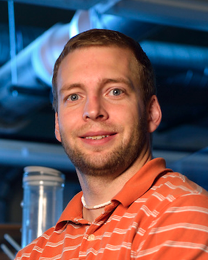 Jared Delcamp
Jared Delcamp
Tuesday, September 12, 2017, 12:30 pm, 215 Williams Hall (joint LaCNS – Organic Chemistry seminar)
Dr. Delcamp is a Professor of Chemistry and Biochemistry at the University of Mississippi
“Photon Management in NIR and SSM Dye-Sensitized Solar Cells”
ABSTRACT: Recently, dye-sensitized solar cells (DSCs) were shown to be the highest power conversion efficiency technology of any solar cell technology when using photons from the beginning of the solar spectrum until 700 nm. Two key directions are apparent in further elevating this technology: (1) broadening the spectral window used, and (2) efficiently subdividing the spectrum further for multijunction devices which can be used in combination with many solar cell technologies. Progress toward designing optimal panchromatic organic sensitizers to use NIR photons based on physical organic concepts such as proaromaticity and cross conjugation will be discussed. Additionally, the design and realization of a series sequential multijunction dye-sensitized solar cell (SSM-DSC) system for effective photon management will be discussed. Ongoing research to optimize this system based on transition metal redox shuttle design and high voltage organic dye design will be analyzed. The SSM-DSC system coupled with electrocatalysts as solar-to-fuel systems has been shown to power water splitting and CO2 reduction coupled with water oxidation from a single illuminated area without external bias.
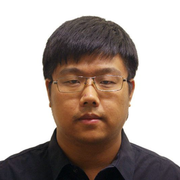 Fei Han
Fei Han
Wednesday, August 9, 2017, 3:00 pm, 1008B Digital Media Center
Dr. Han is a Postdoctoral Researcher at Carnegie Institution of Washington/Florida International University
"Rational and Exploratory Synthesis of New Superconducting Materials"
ABSTRACT: Exploration of new superconductors plays a critical role in advancing research on superconductivity. Aiming to look for new superconductors, I employed solid state synthesis and crystal growth to design and explore new materials. Single crystal/powder X-ray diffraction and electronic transport probes were used to identify the structure of the new materials and reveal the existence of superconductivity or other novel properties in them. In this talk, I will introduce my results on discovering new materials, including the discoveries of various new superconductors and semiconductors. Moreover, a very interesting system with two superconducting domes, LaO1-xFxBiS2, will be discussed in detail. Recently I have also utilized high-pressure techniques in my superconductivity research. With synchrotron X-ray diffraction and X-ray emission spectroscopy, we discovered a spin quenching assisted by a strongly anisotropic compression behavior in the first pressure-induced manganese-based superconductor MnP.
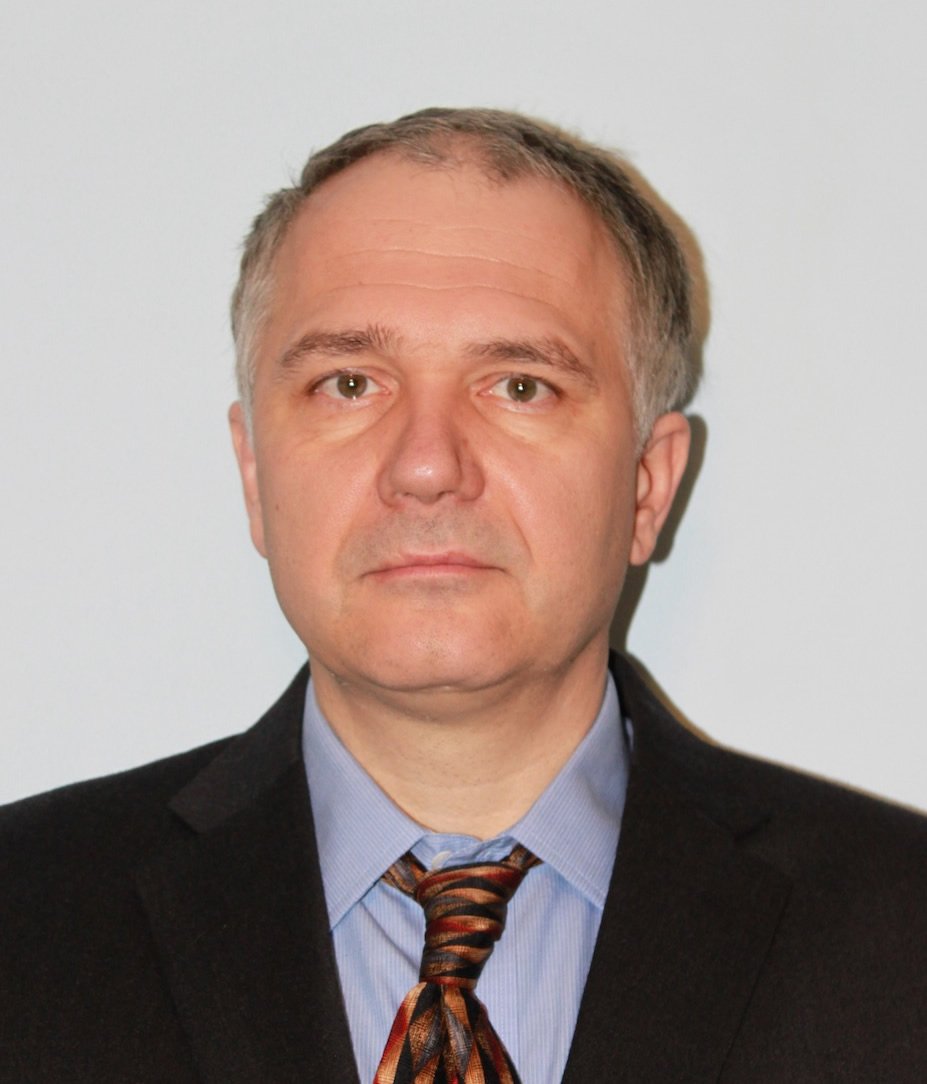 Jan Ilavsky
Jan Ilavsky
Wednesday, July 19, 2017, 3:00 pm, 435 Nicholson Hall
Dr. Ilavsky is a scientist in the X-Ray Science Division, Advanced Photon Source, Argonne National Laboratory
“Extended Range Ultra Small-Angle X-ray, Small-Angle, and Wide-Angle Scattering for Advanced Materials”
ABSTRACT: Development of new high-performance materials, e.g., new aluminum or steel alloys, is critical for advances in energy production and utilization (and many other areas). These materials often exhibit complex microstructures spanning multiple length scales that control their performance. In this context, it is important to simultaneously characterize, ideally in situ or in operando, various facets of the microstructure – for example precipitate shape and size, together with their phase and chemical composition. Combined Ultra-Small, Small, & Wide Angle X-ray Scattering (USAXS/SAXS/WAXS) facility [1] provides data spanning over 5 decades in microstructural size, which can be collected sequentially in 4 to 6 minutes, from the same volume during one in-situ experiment.
Presentation will show selected examples of research taking advantage of these unique capabilities. For example [2], we have studied the Al-Cu-Mg alloys, e.g., AA2024, at different aging conditions. The precipitate structure and precipitation kinetics in is alloy, aged at 190 °C, 208 °C, and 226 °C have been studied using ex situ TEM and in situ combined USAXS/SAXS/WAXS at the APS. TEM provided information concerning the nature, morphology, and size of the precipitates, while USAXS/ SAXS/WAXS provided qualitative and quantitative information concerning the time-dependent size and volume fraction evolution of the precipitates at different stages of the precipitation sequence.
This and other examples will show how the extended-range measurements simplify and speed up new advanced materials characterization and development.
1. J. Ilavsky, P.R. Jemian, A.J. Allen, F. Zhang, L.E. Levine, G.G. Long, Journal of Applied Crystallography, 42, (2009), 469-479.
2. Zhang, F., L. E. Levine, A. J. Allen, C. E. Campbell, A. A. Creuziger, N. Kazantseva
and J. Ilavsky, Acta Materialia 111, (2016), 385-398.
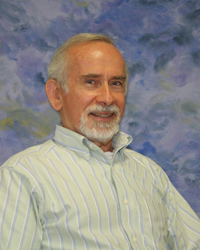 Wayne Saslow
Wayne Saslow
Thursday, July 6, 2017, 12:00 pm, 435 Nicholson Hall
Dr. Saslow is a Professor of Physics at Texas A&M University
"Irreversible thermodynamics of uniform ferromagnets with spin accumulation: Bulk and interface dynamics"
ABSTRACT: Although ferromagnetic excitations were first studied without collisions -- as appropriate to neutron scattering -- collisions are necessary to produce equilibrium and near-equilibrium behavior. Based on a two-band equilibrium picture, we consider the full small-amplitude non-equilibrium spin distribution function, having 10^{23} variables. We argue that, after a short time, collisions reduce the magnetic variables to only the usual magnetization M and the non-equilibrium spin accumulation m. We describe M and m thermodynamically, and then use irreversible thermodynamics to derive their dynamics, both in bulk and at interfaces, where they have distinct boundary conditions.
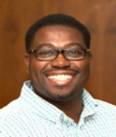 Toby Nelson
Toby Nelson
Friday, April 28, 2017 (joint LaCNS – Macromolecular Chemistry seminar):
Dr. Nelson is a Professor of Chemistry at Oklahoma State University
"Redefining Melanin: From Eumelanin-Inspired Materials to Structure-Property Relationship"
ABSTRACT: Melanin is a unique class of natural occurring pigments found in the hair, eyes, skin and the brain of mammals. Eumelanin is the black-brown variety of Melanin and understood to be a biosynthesized heterogeneous macromolecule containing 5,6-dihydroxyindole and 5,6-dihydroxyindole-2-carboxyic acid. Nature has chosen this substance with such complexity and undefined structure as the centerpiece for so many functions like coloration, radiation hardness, and neuron protector. This presentation will begin with an introduction to what we call Eumelanin-inspired materials. Here, we will explore the tunability of the Eumelanin-inspired indole core for applications such as sensors, OLEDs and antimicrobials. To follow, our progress toward understanding Eumelanin structure-property relationship to define function will be presented.
 Hassina Bilheux
Hassina Bilheux
Monday, April 17, 2017
Dr. Bilheux is a Lead Instrument Scientist at the Neutron Imaging Facility, Oak Ridge National Laboratory
"Neutron Imaging Capabilities at the Oak Ridge National Laboratory"
ABSTRACT: Oak Ridge National Laboratory is home to two of the most powerful neutron sources in the world: the 1.4 MW Spallation Neutron Source (SNS) and the 85 MW High Flux Isotope Reactor (HFIR). Neutron imaging is a non-destructive characterization technique capable of mapping light elements buried in high-Z materials. The technique has been used for defects in materials (fracture, porosity, etc.), in-situ time-dependent measurements such as water uptake in plant roots or Li distribution in battery electrodes, and archeological investigations (identification of a counterfeit object), to name a few.
This presentation gives an overview of recent applications at HFIR CG-1D imaging. Lately, the CG-1D team has prototyped qualitative polarized imaging using white beam neutrons and is currently working toward monochromatic capability to enable quantitative measurements of superconducting materials.
In preparation for the SNS VENUS imaging beamline, the team has developed Bragg edge imaging capabilities combined with neutron diffraction at the SNAP and VULCAN beamlines. Wavelength-dependent neutron transmission exhibits abrupt drops when the neutron wavelength is twice the value of d-spacing, allowing identification of crystalline planes. This technique has been applied to additively manufactured Inconel 718 with different crystalline orientations. Combination of the Bragg edge results with diffraction data is discussed, along with the microstructure interpretation of the results. An attempt at modeling Bragg edges is also presented.
Finally, an overview of the jupyter notebook-based Python iBeatles user interface used to identify and fit Bragg edges is discussed.
 Eugenia Kharlampieva
Eugenia Kharlampieva
Friday, March 10, 2017 (joint LaCNS – Macromolecular Chemistry seminar):
Dr. Kharlampieva is a Professor of Chemistry at the University of Alabama Birmingham
"Polymeric Nanocoatings for Drug Delivery and Cell Transplantation"
ABSTRACT: Bio-inspired fabrication of biologically-active and stimuli-sensitive nanostructured materials is of increasing interest in bio- and nanotechnology. This talk will focus on functional nanothin coatings and hollow nanothin microparticles (capsules) obtained by assembly of synthetic and biological macromolecules on inorganic templates and living cells. We will discuss pH-triggered changes in hydrogel film architecture probed with neutron reflectivity as well as shape transitions in hydrogel microcapsules to be used for controlled drug delivery. We will also address the application of these coatings in cell-based transplantation therapy. We will present immunomodulatory films with diminished inflammatory immune responses deposited on mammalian pancreatic islet cells. These materials provide prolonged cell viability and function to be used in diabetes treatment.
 Yu-Shan Lin
Yu-Shan Lin
Tuesday, February 21, 2017 (joint LaCNS – Physical Chemistry seminar)
Dr. Yu-Shan Lin is an Assistant Professor of Chemistry at Tufts University
"Understanding and Designing Cyclic Peptides"
ABSTRACT: Cyclic peptides (CPs) are highly sought after for several unique applications. For example, CPs can target protein surfaces with high affinity and selectivity, thereby inhibiting specific protein–protein interactions that cannot be easily targeted with other molecules. New inhibitors will enable mechanistic studies to dissect the functions of individual protein–protein interactions in the complicated cellular interactome. However, robust application of this fundamentally interesting class of molecules for these and other purposes is limited by our poor capacity to predict CP structures and the resulting inability to rationally design functional CPs. In this talk, we describe an efficient enhanced sampling method to simulate CPs, using which we aim to fill the knowledge gap of CP sequence–structure relationships, and enable rational design of CPs with desired structures.
 Utpal Chatterjee
Utpal Chatterjee
Monday, February 20, 2017
Dr. Utpal Chatterjee is a Professor of Physics at the University of Virginia
"Electronic phase diagram of High Temperature Superconductors"
ABSTRACT: Even though High Temperature Superconductors (HTSCs) were discovered three decades ago, a microscopic theory is yet to be realized for this unique class of materials. An important step towards this is to characterize the normal state of the HTSCs in great detail. From our temperature (T) and carrier concentration (d) dependent Angle Resolved Photoemission Spectroscopy (ARPES) measurements on Bi2Sr2CaCu2O8+d (BISCO 2212) HTSCs, we find that unlike in conventional superconductors, where there is a single temperature scale Tc separating the normal from the superconducting state, HTSCs are associated with two additional temperature scales. One is the so-called pseudogap scale T*, below which electronic excitations exhibit an energy gap. The second is the coherence scale Tcoh, below which lifetimes of quasiparticles get enhanced. We observe that T*(d) and Tcoh(d) cross each other near optimal carrier concentration, i.e. the d for which Tc (d) attains its maximum value. There is an unusual phase in the normal state where the electronic excitations are gapped as well as coherent. Quite remarkably, this is the phase from which the superconductivity with maximum Tc emerges. We also conduct direct comparison between the single-particle spectral functions from charge density wave systems and from the pseudogap phase of BISCO 2212 HTSCs. Our data do not seem to be consistent with the propositions that the energy gap for T< T* is due to some charge ordering. Our data are rather consistent with the presence of incoherent pairs in the pseudogap phase. Moreover, our experimental finding that the two crossover lines T*(d) and Tcoh(d) intersect is not compatible with the theories invoking “single quantum critical” point near optimal doping, rather it is more naturally consistent with theories of superconductivity for doped Mott insulators.
 Anibal J. (Timmy) Ramirez-Cuesta
Anibal J. (Timmy) Ramirez-Cuesta
Monday, February 13, 2017
Dr. Ramirez-Cuesta is a Chemical Spectroscopy Group Leader in the Chemical and Engineering Materials Division, Neutron Sciences Directorate at Oak Ridge National Laboratory
"Neutrons and Numbers: The VISION challenge. The world’s first high throughput Inelastic Neutron Scattering Spectrometer"
ABSTRACT: Molecular spectroscopy is a very powerful tool to study the dynamical properties of solid, liquid and gases. Inelastic Neutron scattering is a very powerful tool to study hydrogen-containing materials. With the development of neutron spallation sources, and the use of epithermal neutrons, inelastic neutron scattering can measure the vibrational spectra of materials on the whole range of vibrational motions (0-4400 cm−1) and effectively opening up the field of neutron spectroscopy. INS is a technique that was mostly used to study hydrogen-containing materials due to the high cross section of hydrogen.
The recently commissioned VISION spectrometer at the SNS in Oak Ridge Tennessee has an increased overall flux at low energy transfers up to 4000 times over its predecessors and it has unprecedented sensitivity. I will examine the limits of what is now possible in INS thanks to VISION. From the determination of INS spectra of publishable quality in minutes (for samples in the gram quantity range), measuring the signal of samples in the milligram range to the direct determination of the signal of 2 mmol of CO2 adsorbed on functionalized catalysts.
Sample environment developments are a crucial part of an effective neutron scattering program, at VISION we have developed the world’s largest single crystal diamond anvil cell and measured the INS spectra of 1 mm3 of a HMB sample. Gas handling experiments are trivial to perform. A sample changer designed for VISION is being built, it is a whole new concept that will allow continuous operation for large number of samples (hundreds at a time) that will enhance the mail-in program for sample measurement. Recently, a simultaneous Raman and INS center-stick has been developed and tested in VISION measuring simultaneously the rotational spectra of hydrogen in the gas, liquid and in the solid state as function of the relative para-ortho hydrogen concentrations. We also have in-situ dielectric spectroscopy capabilities. There is a catalysis cell and gas handling equipment that is currently being built to perform in-situ chemical reactions.
Finally, the major challenges that we are facing will be discussed, in particular methods to automate data analysis and interpretation through computer modelling. We have recently commissioned VirtuES (VIRTUal Experiments in Spectroscopy), March 2016, a computer cluster dedicated to analyse VISION data. We are developing the software to maximize the potential of the technique by generation of automated VDoS, generation of thermodynamic data, creation of databases etc.
Brian K. Long 
Friday, February 3, 2017 (joint LaCNS – Macromolecular Chemistry seminar)
Dr. Long is a Professor of Chemistry at the University of Tennessee Knoxville
"Utilizing Coordination-Insertion Based Polymerizations for the Synthesis of Tailored Polyolefins and Gas Separation Membranes"
ABSTRACT: Coordination-insertion based polymerization methods provide a multitude of opportunities for enhanced control over catalytic activity, selectivity, and reactivity. Through tailored catalyst development and macromolecular design, the Long Research Group leverages these advantages to synthesize unique and/or tailored polymeric structures for a variety of applications. In this talk, we will demonstrate the potential power of these coordination-insertion based polymerization methods through two studies. First, we will provide fundamental evidence that redox-active olefin polymerization catalysts can be effectively used to modulate polyolefin microstructure and copolymer composition via simple in situ changes in a catalyst's oxidation-state. Second, we will demonstrate that careful catalyst selection can enable access to a unique class of polymers that was previously believed to be inaccessible, and that those materials are extremely attractive as highly efficient gas separation membranes.
2016
 Michael Ohl
Michael Ohl
December 12, 2016, 3:00 pm, 1008B Digital Media Center
Dr. Ohl is Lead Instrument Scientist at Spallation Neutron Source, Oak Ridge National Laboratory
"Neutron Spin Echo: The Technology and the Science"
ABSTRACT: When Neutrons were first used as probes to understand the properties of matter, it became immediately obvious that inelastic processes could be studied as well. The higher the energy- resolution of Neutron scattering instruments got, the better one could unravel slow dynamics.
Subsequently, Neutron scattering instruments were pushed more and more to higher resolution and more ideas were developed. The principle of Neutron Spin Echo (NSE) to encode and decode the energy transfer of Neutrons in the spin of the scattered Neutrons has been well known since 1971.
About eight years later IN11, the first NSE spectrometer worldwide, was built at the Institute Laue-Langevin in Grenoble, France and went into operation with first results. This was the start of many more NSE spectrometers to come later and up to now NSE spectrometers still possess the highest energy resolution in the field of Neutron scattering. As of today about six NSE spectrometers of the generic IN11 type are operated worldwide in Europe and the USA. The newest instrument is the NSE at the Spallation Neutron Source in Oak Ridge, TN, USA. A wide field of scientific questions can be addressed by this new type of instrument. They are mainly in the field of soft matter e.g. polymer main chain and side group motions, glass forming properties, internal dynamics of proteins, and functionalities of bacteria to name just a few. In this talk, the latest technology and newest scientific questions will be addressed.
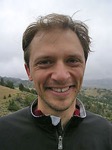 Daniel Hussey
Daniel Hussey
November 14, 2016, 3:00 pm, 1008B Digital Media Center
Dr. Hussey is Staff Scientist at the Neutron Imaging Facility, NIST
“Seeing the World with Neutron Vision”
ABSTRACT: In this talk, I’ll discuss how neutron imaging has benefited fuel cells, how one can image microstructural details in crystals and polymers, and introduce the idea of the neutron microscope. Neutrons primarily interact with matter via the strong nuclear force (as opposed to the electron density) and so provide a complementary view of the world compared to more conventional probes of matter. In particular, neutrons have a very high sensitive to hydrogen while being very insensitive to common metals such as aluminum. This has enabled neutron imaging to play a key role in understanding the water transport in hydrogen fuel cells. Because neutrons can also be thought of as both particle and wave, it is possible to create phase images which can resolve smaller changes than standard imaging, and also reveal structures that are much smaller than the spatial resolution of the image. An ongoing challenge in any neutron scattering or imaging measurement is the inherently low neutron intensity as compared to what is possible at modern x-ray synchrotrons. This is partly due to the difficulty in focusing neutrons as the refractive index differs from one by only 1-10 ppm. A new reflection base lens technology shows great promise to create the world’s first practical neutron microscope.

November 4, 2016, 3:30 pm, A101 Life Science Bldg
Dr. Banerjee is a Postdoctoral Fellow at Oak Ridge National Laboratory
"Search of Kitaev Physics and Majorana Fermions in a honeycomb magnet"
ABSTRACT: As dimensions get reduced, the effects of quantum fluctuations increase
leading to interesting emergent quantum phenomena and new quantum states. The 2D Kitaev
quantum spin liquid (QSL) is such a quantum state of matter which occurs when the
three types of bonds of the honeycomb lattice have mutually incompatible Ising interactions.
This Kitaev QSL is particularly intriguing since its magnetic excitations – which
appear as a spectrum of Majorana Fermions - are theorized to realize a particular
topological quantum computing technology in the solid-state. Here I describe the comprehensive
characterization of the graphene-like Kitaev candidate material α-RuCl_3 using both
real and reciprocal space measurements. This transition metal halide has a relatively
high spin-orbit coupling in the presence of an octahedral crystal field ensuring a/
S/=1/2 ground state enhancing quantum fluctuations, which creates a conducive environment
for the realization of Kitaev physics.
Using inelastic neutron scattering, we explicitly measure a thermally-resilient broad
spinon continuum. This feature is independent of the long-range ordering and inexplicable
by classical spin-wave theories, but matched the predictions of the high-energy 2D
Majorana Fermions expected from exact Kitaev calculations, placing this material proximate
to the true Kitaev QSL. We mapped the detailed energy-momentum resolved dispersion
of this mode using single-crystal TOF neutron scattering, which would be the first
measurement of its kind on a Kitaev continuum. Our measurements yield critical insights
into /how /and /by how much /a real material departs from the ideal Kitaev behavior.
Finally, I discuss our very recent field-dependent data which teases a particular
route towards achieving the ideal QSL scenario.
 Duane Johnson
Duane Johnson
October 31, 2016, 3:00 pm, 1008B Digital Media Center
Dr. Johnson is Chief Scientist at Ames Laboratory, U.S. Department of Energy, and F. Wendell Miller Professor of Materials Science & Engineering at Iowa State University
“Mapping and Manipulating Materials Transformation Pathways and Properties”
ABSTRACT: Electronic-structure-based thermodynamic methods to explore, explain, and control materials phase transformations will be described with applications on novel, complex multicomponent alloys and responsive materials to reveal phenomena such as (i) transformations in shape-memory alloys and new structures, (ii) short- and long-order in high-entropy alloys, (iii) nanoalloy catalysts, (iv) magneto-structural collapse in magnets, and (v) Lifshitz transitions, and quantum critical points in iron-arsenide superconductors. To design multicomponent materials and tailor their functionality, we apply these unique techniques to quantify stability and properties by mapping global solid-solid transformations (e.g., order-disorder and competing long-range order (LRO) states) and local structural instabilities (e.g., short-range order, SRO). In particular, thermodynamic linear-response theory is used to predict SRO involving coupled electronic, chemical, magnetic, and structural fluctuations in complex N-component systems; the solid-state nudged-elastic band method was extended to map pathways (enthalpies and barriers) involving non-conserved order parameters responsible for, e.g., magneto-structural collapse.
 Bhuvnesh Bharti
Bhuvnesh Bharti
October 3, 2016, 3:00 pm, 1008B Digital Media Center
Dr. Bharti is a Professor of Chemical Engineering at Louisiana State University
“Neutron Scattering for Investigating the Surface Aggregates Formed by Amphiphiles on Nanomaterials”
ABSTRACT: Nanoscale functional materials are of interest in many applications, ranging from catalysis, membrane processes, and chromatography to new areas such as microelectronics and medical diagnostics. Surfactants or related amphiphilic substances are involved in many of these fields, and understanding their surface-binding characteristics would enable the control and design of the assembly processes leading to the desired properties of the materials. An important characterization tool for addressing interfacial properties in aqueous soft matter systems is Small-Angle Neutron Scattering (SANS). To this end, we have applied of SANS to investigate the adsorption of non-ionic surfactants on spherical silica nanoparticles and in the periodic cylindrical pores of SBA-15 material. Using SANS at silica contrast matching H2O/D2O solution, we find that the self-assemblies formed by the surfactants on the silica nanomaterials are strongly dependent on their surface-binding energy. This binding energy between surfactant and silica can be altered by co-adsorbing modifier molecules (here lysine), which further change the characteristics of the dispersions and the surface aggregates formed by the amphiphiles. I will also present our recent study on the formation of fatty acid liquid nanocapillary bridges between iron oxide nanoparticles, where I will highlight the major challenges in SANS experiments and modeling of this magnetic-fatty acid composite materials.
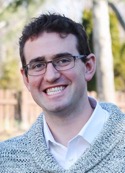 Christopher Arges
Christopher Arges
September 26, 2016, 3:00 pm, 1008B Digital Media Center
Dr. Arges is a Gordon A. and Mary Cain Professor of Chemical Engineering at Louisiana State University
“Molecular Level Engineering of Block Copolymer Electrolytes’ Structure via Directed Self-assembly”
ABSTRACT: Solid-state ion conducting polymers (i.e., polymer electrolytes) are found at the heart of numerous electrochemical processes that store and convert energy, synthesize chemicals, and purify water. One key functional property of these materials is their ion conductivity – a key transport property that governs the ohmic resistance in electrochemical devices. Block copolymer electrolytes are a subset of polymer electrolytes and they are attractive materials because their micro-phase separated architecture yields greater conductivity over their random copolymer counterparts. However, there is a poor understanding between molecular level structure and bulk material properties like ion transport.
In this work, the process of directed self-assembly controlled the micro-phase separated structure in block copolymer electrolytes with astonishing fidelity. Engineering the block copolymer electrolyte structure was achieved by first directing the self-assembly of the non-ionic variant block copolymer (poly(styrene-block-2-vinyl pyridine) using solvent vapor annealing on non-preferential layers or topographical patterned substrates. After self-assembly, an invasive, gas phase Menshutkin reaction with an alkyl halide converted the pyridine moiety to n-methyl pyridinium iodide – anion charge carriers. The reaction was benign to the self-assembled molecular structure. Complementary x-ray scattering (GI-SAXS and RSoXS) and electron microscopy (SEM and EDX mapping via STEM) substantiated the introduction of ionic groups without detriment to structural integrity. Key results from the ordered block copolymer electrolytes highlight that ion conductivity followed an exponential growth curve with respect to ion domain connectivity. Ion domain alignment to electrode surfaces with a tortuosity of 1 yielded a 4 order of magnitude improvement in ion conduction over anti-aligned ionic domains. The results of this work have far reaching implication for the rationale, molecular level design of block copolymer electrolytes.
 Paul Rupar
Paul Rupar
September 2, 2016, 12:30 pm, 214 Williams Hall
Dr. Rupar is an Assistant Professor of Chemistry at the University of Alabama
“The Living Polymerization of Aziridines and the Synthesis of Inorganic Element Containing Conjugated Polymers”
ABSTRACT: The first half of the talk will overview our work on the controlled polymerization of polyethyleneimine (PEI). PEI, a polymer with a -CH2CH2N(H)- repeat unit, is used in a wide variety of applications such as gene transfection, gas absorption/purification, and removal of metals from waste. PEI is typically formed by the cationic ring-opening polymerization (ROP) of aziridine, which produces a highly branched polymer (BPEI). The synthesis of BPEI is difficult to control, limiting the incorporation of PEI into intricate polymer structures such as block copolymers. We will demonstrate that the judicial selection of N-protecting groups enables the living anionic ROP of N-functionalized aziridines and subsequent conversion to linear PEI.
The second part of the talk will discuss conjugated polymers containing boron and phosphorus atoms. The introduction of inorganic p-block elements into conjugated polymers is a powerful technique to create new functional materials. The incorporation of 3-coordinate boron is attractive as the boron empty p-orbital increases polymer electron affinity and provides the potential for polymers with inherent sensing applications. In the case of phosphorus containing polymers, the phosphorus atom is easily derivatizable and thus provides a handle for introducing new functionality into conjugated polymers.
 Pinaki Das
Pinaki Das
Wednesday, July 6, 2016
Dr. Das is a Postdoctoral Researcher at Ames Laboratory, Iowa State University.
"Neutron scattering studies in quasicrystal and quasicrystalline approximants"
ABSTRACT: Quasicrystals, discovered by Dan Shechtman in 1982, are distinguished by the presence of sharp Bragg reflections with rotational point symmetries that are inconsistent with periodic translational order [1, 2]. Nevertheless, the resolution limited Bragg peaks observed for the best ordered icosahedral quasicrystals demonstrate that the atomic order is truly long-range, albeit aperiodic. In the 30 years since Shechtman’s discovery, significant advances have been made in our knowledge of the atomic scale structure, but less progress has been made in our understanding of the consequences of aperiodicity on electronic and magnetic properties. Here I will present our recent neutron scattering studies on the icosahedral quasicrystal i-Tb-Cd and its related quasicrystalline approximant TbCd6. Though TbCd6 shows a long-range antiferromagnetic order (TN = 24 K), only spin glass like behavior is observed in i-Tb-Cd with a spin freezing temperature of TF = 6 K. In the first part, I will show our detailed study of the elastic diffuse scattering observed in i-Tb-Cd associated with the short range magnetic correlations. In the second part, I will present our inelastic neutron scattering studies of the crystal field (CF) excitations in the approximant TbCd6, where the CF levels of the local Tb ion is close to a pentagonal symmetry.
 Sanat Kumar
Sanat Kumar
Monday, April 25, 2016
Dr. Kumar is a Professor in the Chemical Engineering Department of Columbia University.
"Nanocomposites with grafted nanoparticles"
ABSTRACT: A central area of research in the soft matter community is in inorganic/organic hybrid materials with nanoscale inorganic particles. These materials have been focused on due to their promise of having synergistic thermal, mechanical and optical properties relative to the pure materials. It is now accepted that the spatial distribution of the inorganic nanoparticles critically affects the properties of the resulting materials, but a grand challenge is to control the spatial distribution of the inorganic, hydrophilic nanoparticles in the organic, hydrophobic polymer matrix. I focus on one particular approach to controlling nanoparticle spatial dispersion, the use of polymer-grafted nanoparticles. In the case where the NP and the grafted polymer chains energetically “dislike” each other, we have an architecture akin to a microphase separated block copolymer or a surfactant. Analogous to these “surfactants” these grafted nanoparticles also assemble into a range of morphologies, thus giving us the unprecedented ability to control the particle dispersion state.
In this talk I first focus on the factors controlling this assembly and use this knowledge to consider the utility of other approaches to self-assembly – we show that the use of crystallizable polymers allows us to control nanoparticle order, in particular by varying the rate at which these materials crystallize. This allows us to mimic the growth of organisms such as nacre and oysters, whose shells combine the dual advantages of high strength and toughness. In a different vein, these grafted nanoparticles show the ability to creating membranes that have the potential to revolutionize the separation of hydrocarbons and in carbon sequestration.
 Itamar Kimchi
Itamar Kimchi
Monday, April 4, 2016
Dr. Kimchi is a Pappalardo Postdoctoral Fellow in the Department of Physics at Massachusetts Institute of Technology.
"How to identify and resolve beyond-geometrical frustration"
ABSTRACT: In this talk, we will discuss recent theoretical developments triggered by the experimental discoveries of iridium oxides α,β,γ-Li2IrO3. In these polytypes, spin-orbit-coupled J=1/2 moments form 2D and 3D lattices (honeycomb, hyperhoneycomb and stripyhoneycomb) which generalize the 2D honeycomb lattice. Scattering experiments on all three of these compounds have uncovered a peculiar non-coplanar incommensurate magnetic order, involving spirals which counter-rotate across neighboring sites. We discuss the emergence of this ordering, and the striking similarities visible across the three Li2IrO3 structures.
The model Hamiltonians that capture the materials indicate strong magnetic frustration, which arises from spin-orbit coupling. Tuning the frustration, perhaps by just a 10% Hamiltonian perturbation, exposes a fractionalized phase: Kitaev's three-dimensional quantum spin liquid (QSL). What is its range of stability to the competing Hamiltonian terms which occur in the materials, such as antiferromagnetic Heisenberg exchange? The frustration prohibits direct computations. Instead, we demonstrate a viable approach by numerically solving the model in a fully quantum infinite-dimensional approximation, which captures both the magnetically ordered and the QSL phases. Finally, we discuss the phenomenology of the QSL phase, including the role of its emergent magnetic-like field lines in stabilizing its deconfined fermion excitations to finite temperatures. The resulting phase transition is a signature unique to three-dimensional fractionalization.
 Rex Hjelm
Rex Hjelm
Monday, March 28, 2016
Dr. Hjelm is an Instrument Scientist at the Los Alamos Neutron Science Center, Los Alamos National Laboratory.
"Dispersion morphology of Nafion in the fabrication of fuel cell membrane electrode assemblies: relationships to electrolytic fuel cell durability and performance"
ABSTRACT: Modern polymer electrolyte fuel cells (PEFCs) require technologies that generate higher performance, durability and component structural integrity. The membrane electrode assemblies (MEAs) of PEFCs typically contain a Pt/carbon black catalyst and an ionomer, such as Nafion. In one process MEAs are produced by solution casting from a dilute solvent dispersion of these components. We consider current hypotheses relating fuel cell durability and MEA toughness to changes in these components with multiple fuel cell voltage potential cycling: namely, that fuel cell durability is associated with the loss of electrochemical (Pt) surface area (ECSA) and that MEA mechanical properties are due to ionomer crystallinity. We weigh these hypotheses against an alternative that both fuel cell durability and MEA toughness are the result of dispersion particle morphology and its evolution during the course of drying to the MEA film. Small-angle neutron scattering (SANS) using the Lujan Center instrument, LQD, was used to show that different solvents determine the dispersion particle structure due to the amphiphilic nature of Nafion and that the morphology of the dispersion in different solvents follow different evolutionary paths on drying. The SANS results suggested that the ability of the dispersion particles to form an entangled network leading to a homogeneous, reversible gel alone was the determining factor for mechanical toughness of the MEA and fuel cell durability. It was found that neither toughness correlated with Nafion crystallinity nor was durability correlated with changes in the ECSA with voltage cycling. These results show the power of SANS as a characterization technique, when used along with other characterization methods and property and performance metrics, to address complex issues in materials science process, structure, properties and performance characteristics. Our work lends support to the hypothesis that MEA durability and toughness are affected by the dispersion morphology and are likely associated with the ability of Nafion to chain entangle.
 Changwoo Do
Changwoo Do
Friday, March 11, 2016
Dr. Do is an Instrument Scientist at the Spallation Neutron Source, Oak Ridge National Laboratory.
ABSTRACT: Polymer self-assembly studies using small-angle neutron scattering
 Antonio Faraone
Antonio Faraone
Monday, February 15, 2016
Dr. Faraone is a Postdoctoral Researcher at NIST Center for Neutron Research.
ABSTRACT: Quasielastic Neutron Scattering for the investigation of dynamics in soft condensed matter: polymer nanocomposites, molecular glass formers, and phospholipid vesicles Quasielastic neutron scattering (QENS) is a scattering technique for the investigation of relaxation dynamics with nanoscale space and time resolution. I will introduce the NIST Center for Neutron Research (NCNR) as a user facility with particular emphasis on its capabilities for QENS measurements on soft condensed matter. In the second part of my talk I will review, three scientific projects I have been involved recently with, which have extensively employed QENS. A model nanocomposite where miscible nanoparticle-bound polymer and matrix chains have a large difference in their glass-transition temperatures was investigated using different QENS techniques; the data clarify how the Rouse dynamics and the self-confinement of the chains are affected when cooling the bound polymer below its glass transition. Coherent QENS measurements allow investigating the dynamics of the nanoscopic structures present in associating molecular liquids; on the basis of the obtained results, the relation between the lifetime of the supramolecular associates and the structural relaxation is discussed. The elastic properties of phospholipid bilayers in unilamellar vesicles can be uniquely investigated using Neutron Spin Echo Spectroscopy; the effect of the addition of proteins on the properties of the membrane will be reviewed in two relevant cases. These examples provide an overview, necessarily partial, of the research efforts, currently being carried out at NCNR, on the dynamics of soft condensed matter systems.
2015
Volker Urban
Monday, November 16, 2015
Volker Urban is active divison director and Energy and the Environment Group Leader.
"Unique Opportunities for Neutrons in Soft Materials and Biology"
ABSTRACT: Long-wavelength neutrons are an ideal probe for soft and biological materials because of their sensitivity to hydrogen, the possibilities of hydrogen/deuterium contrast variation and the fortunate combination of the neutron’s wavelength and energy. The seminar will review research questions in soft matter and biology that have used neutrons for extracting key information that was not accessible by other techniques. Examples include breakthroughs in our understanding of natural and man-made materials such as measuring the conformation of single polymer chain molecules in their natural melt or network environment, observing details of structural and compositional changes in cell walls during biomass industrial processing, and visualizing small proteins embedded in complex inorganic matrices. The unique capabilities of neutrons point to clear opportunities in soft matter and biology and suggest a science strategy that embraces development and investments for optimized neutron instruments and sample environments, computational analysis and experiment optimization, and chemical and biochemical deuterium isotope labeling.
Abhishek Pandey
Monday, November 9, 2015
Abhishek Pandey is a Postdoctoral Researcher at LSU Department of Physcis & Astronomy.
"Search for interesting behaviors beyond iron-based materials in tetragonal pnictides"
ABSTRACT: After the discovery of high-temperature superconductivity (SC) in the iron-based tetragonal compound LaFeAsO1-xFx in 2008, a worldwide effort began to understand the mechanism of SC and to discover other new superconductors in the related structures. This effort quickly led to the discovery of SC in structurally related 122-type iron-arsenides where the parent compounds with the composition of AFe2As2 (A = Ca, Sr and Ba) crystallize in tetragonal ThCr2Si2-type structure. Soon the interest expanded beyond the iron-based compounds and some exciting observations were made in other arsenide materials. Our stimulating observations of unexpected stripe-type antiferromagnetic correlations in SrCo2As2 and the discovery of a novel magnetic ground state in hole-doped BaMn2As2, where half-metallic itinerant ferromagnetism of doped holes coexists with a local-moment antiferromagnetism of Mn lattice, hint toward the abundance of possibilities contained in the transition metal-pnictide systems. I shall discuss some of our recent works on SrCo2As2 and hole-doped BaMn2As2 and their possible impact on the future research in this field. I will also briefly discuss about a new family of layered transition metal-pnictide materials recently discovered by us.
 Chetan Dhital
Chetan Dhital
Friday, May 8, 2015
Chetan Dhital is a Postdoctoral Researcher at Oak Ridge National Laboratory.
"Electronic phase separation and magnetic phase behavior in the Ru-doped spin-orbit Mott insulator Sr3Ir2O7"
ABSTRACT: Recent theoretical and experimental studies have predicted a very interesting electronic phase diagram in 5d iridate system arising due to interplay of spin orbit interaction and the electronic correlation. Spin-orbit Mott phase is one such electronic phase realized in Ruddelsden-Popper (RP) series [Srn+1IrnO3n+1] oxides. Sr3Ir2O7 (n=2) and Sr2IrO4 (n=1) are two representative candidates of this series. Although their ground state properties are studied to some extent, very little is known regarding how the properties of their antiferromagnetic, insulating, parent states evolve upon carrier substitution. One way of experiencing the strength and relevance of electronic correlation in any condensed matter system is by doping charge carriers. The presence of electronic correlations in the host system determines the fate of the dopant and hence stabilizes a new electronic/magnetic ground state. I will discuss about importance of electronic correlations in one such doped system Sr3(Ir1-xRux)2O7 using combined neutron scattering, electric transport and magnetization techniques. Our studies show that the Mott insulating state of Sr3Ir2O7 is remarkably robust as the in-plane doped holes remain largely localized within a nanoscale phase-separated ground state and only generate a metal–insulator transition (MIT) near the two-dimensional (2D) percolation threshold. The resulting electronic phase diagram also reveals the surprising persistence of antiferromagnetic (AF) order deep into the metallic phase and suggests emergent itinerant magnetism at the interface between the AF-ordered spin-orbit Mott phase of Sr3Ir2O7 and the nearly magnetic Fermi liquid electronic phase of Sr3Ru2O7.
Joseph Strzalka
Monday, May 4, 2015
Dr. Strzalka’s research interests include proteins at interfaces, organic photovoltaics, grazing incidence x-ray scattering, and liquid surface scattering. He earned his PhD in Physical Chemistry and MS in Physics at the University of Pennsylvania.
"Elucidating the Structure-Performance Relationship in Organic Photovoltaics (OPVs) by Grazing Incidence X-Ray Scattering"
ABSTRACT: Since the introduction of the Bulk Heterojunction (BHJ) architecture in the mid 90s, organic photovoltaic devices have made steady progress toward improved power conversion efficiency, and are now poised to move from niche products to large scale commercial applications. In the BHJ, the photoactive layer consists of electron donor and acceptor materials in a bicontinuous phase blended on the nanoscale. Grazing incidence x-ray scattering, capable of characterizing thin film nanomorphology of surfaces and interfaces, has emerged as a key technique for investigating OPV materials. The hierarchical variety of lengthscales present in OPV materials requires both grazing incidence small- and wide-angle x-ray scattering, the latter recently enabled by improvements to the GISAXS instrument at 8-ID-E of the Advanced Photon Source. I will describe grazing-incidence studies at 8-ID-E that have contributed toward unraveling the complex relationship between OPV materials, processing and performance.
Yuen Yiu
Monday, April 27, 2015
Yuen Yiu is a Graduate Research Assistant in Condensed Matter Physics at the University of Tennessee & Oak Ridge National Lab
"Studies of Strongly Correlated Electron Systems Using Neutron Scattering"
ABSTRACT: Condensed Matter Physicists strive to continue to solve the puzzles at the
frontier of material research. We look at 3 separate materials and present results
of the studies from neutron scattering experiments.
First is an investigation of phase transitions in Ru/Fe substituted PrFeAsO. PrFeAsO
is a member of the 1111 family of iron pnictides, in which superconductivity can usually
be induced by suppressing the magnetic and structural transitions via carrier doping.
We have used Neutron Powder Diffraction to investigate the effect of isoelectronic
substitution on these transitions in Ru/Fe substituted PrFeAsO.
Second is the study of the helimagnetic ordering in Cr doped FeGe. Both CrGe and FeGe
are in the B20 cubic structure, where CrGe exhibits no long range magnetic order down
to at least 2K, and FeGe orders helimagnetically at 280K. We use Small Angle Neutron
Scattering to study the doping dependence of helimagnetism of Cr doped FeGe.
Finally, we examine the lattice dynamics in the rocksalt structure compounds: UC and
US. A recent inelastic neutron scattering experiment has revealed quantum harmonic
oscillator behavior of N atoms in UN. We deduce that other uranium rocksalts should
also exhibit such behaviors. We use Time-Of-Flight Inelastic Neutron Scattering to
extend the study on the dependence of quantum harmonic oscillations in uranium rock
salts.
Feng Ye
Monday, April 20, 2015
Dr. Ye’s research focuses on phase transition, magnetic ordering, and spin dynamics of strongly correlated electron materials such as magnetoresistive oxides, frustrated systems, and multiferroics materials using neutron scattering techniques.
"Tuning the magnetism in the multiferroic Mn1-xCoxWO4"
ABSTRACT: Multiferroic and magnetoelectric materials have attracted renewed attention since the magnetic orders breaks the spatial inversion symmetry and give rise to a ferroelectric state with a macroscopic polarization [1]. The frustrated nature of the magnetic state in multiferroic MnWO4 is the reason [2] for its extreme sensitivity of the ferroelectric/magnetic orders to small perturbations in form of magnetic and electric fields, external pressure, and chemical substitutions [3-5]. Using neutron diffractions, we have characterized the effect of cobalt substitution on the magnetic configuration and corresponding multiferroic behavior [6]. A complex phase diagram with multiple polarization flops upon increasing Co content is observed. Two critical concentrations separate the multiferroic phases with distinct spin structures and orientation of the ferroelectric polarizations. With application of hydrostatic pressure, we further examine the evolution of spin structures at various Co concentrations. Our neutron scattering results provide critical understanding of the pressure induced polarization-switching in the doped sample.
[1] T. Kimura et al., Nature 426, 55 (2003).
[2] F. Ye et al., Phys. Rev. B 84, 179901 (2011).
[3] R. P. Chaudhury et al., Phys. Rev. B 83, 014401 (2011).
[4] F. Ye et al., Phys. Rev. B 78, 193101 (2008).
[5] N. Poudel et al., Phys. Rev. B 89, 054414 (2014).
[6] F. Ye et al., Phys. Rev. B 86, 094429 (2012).
 Arun Yethiraj
Arun Yethiraj
Monday, April 13, 2015
Dr. Yethiraj is Professor of Chemistry at the University of Wisconsin-Madison, where he focuses on theoretical studies of soft condensed matter. His research has two components: the development of methods, and the application of these methods to understand the structure and dynamics of condensed phases. Some areas of interest are polymers in ionic liquids, gemini surfactants, and coarse-grained force fields for complex fluids. He is a Fellow of the American Physical Society and recipient of the National Science Foundation CAREER Award. He has served as Senior Editor of the Journal of Physical Chemistry since 2007.
"Self-assembly in complex fluids"
ABSTRACT: The self-assembly of molecules into nano-structured materials is a fascinating process because small changes in intermolecular interactions can have a large impact on the final mesoscopic structures. An interesting goal is the directed self-assembly of molecules where the chemical nature of the molecules drives the assembly into specific nanostructures. In this talk I will discuss two classes of molecules: lipid/peptide mixtures and Gemini surfactants. In the former specific interactions between the peptides and lipids causes lipid segregation and the formation of curved interfaces. Gemini surfactants form lyotropic liquid crystalline phases. Using computer simulation we show that both non-electrostatic and electrostatic interactions play an important role in the self-assembly of these systems, and both are promising candidates for chemistry directed self-assembly.
 John Ankner
John Ankner
Monday, March 23, 2015
Dr. Ankner is a Liquid Reflectometer Instrument Scientist at Oak Ridge National Laboratory.
"Studies of Polyelectrolyte Multilayers with the SNS Liquids Reflectometer"
ABSTRACT: Layer-by-Layer (LbL) assembly performed via alternating adsorption of water-soluble polymers at surfaces enables fabrication of films on almost any substrate, with nano-scale control over film composition, structure, and properties. Neutron reflectivity offers a window into the internal structure of Layer-by-Layer grown films. The dependence of neutron refractive index on nuclear rather than electronic scattering allows one to substitute deuterons (2H) for protons (1H) to highlight features of interest within a film. Deuterated precursors are available for a wide range of polyelectrolytes and the polymers themselves for commonly used species, such as poly(styrene sulfonate) and poly(methacrylic acid). By imposing rigorous mass balance and employing simplified block models, one can reduce the number of model parameters and extract meaningful structural information from reflectivity data. We will describe how to construct and constrain multilayer models and present application of these methods to various LbL structural problems, such as environmental response, the dependence of film quality on deposition parameters, adsorption of protein layers, asymmetric and salt-mediated diffusion, and the formation, structure, and pH-response of hydrogels.
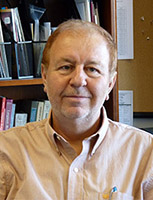 Yuri Lvov
Yuri Lvov
Friday, February 13, 2015
Dr. Yuri M. Lvov is a Professor of Chemistry, Tolbert Pipes Eminent Endowed Chair on Micro and Nanosystems at the Institute for Micromanufacturing, Louisiana Tech University. He earned his Ph.D. in Physical Chemistry (protein crystallography) from #1 Russian university, M. Lomonosov's Moscow State University in 1979, then worked at the Institute of Crystallography, Russian Academy of Sciences where he earned a Doctor of Science in physics in 1991. After the break up of the Soviet Union, he worked in world famous research centers in Germany (Max Planck Institute for Colloids), Japan (National Institute of Materials Science, Tsukuba), and USA (Naval Research Laboratory, Washington DC). In 1999, Dr. Lvov came to the Institute for Micromanufacturing at LaTech from the Center for Biomolecular Science and Engineering, Naval Research Lab.
His area of specialization is nanotechnology including nanoassembly of ultrathin organized films, bio/nanocomposites, nano/construction of ordered shells on tiny templates (drug nanocapsules, shells on microbes and viruses), clay nanotubes for controlled release of anticorrosion and bioactive agents. Y. Lvov has 12 US, Australian and Japanese patents on nanoassembly. He was among pioneers of the polyelectrolyte layer-by-layer (LbL) assembly, - a nanotechnology method which, after his first papers in 1993, followed by many thousands publications by researchers all over the world. LbL nanoassembly already found industrial applications in HPLC, for eye lens modification, improvement of cellulose fiber for better fabric and paper, microcapsules for insulin sustained release, cancer drug nanocapsules, anticorrosion protection, and others. Yuri Lvov edited three books, published 22 book chapters, and 214 peer reviewed papers on nanosystems. Lvov’s total citation index is above 13,500 which is an outstanding result, and his h-index is 58.
His NSF, NIH, NASA, DoE grants and industrial contracts exceeded $9 million in the last ten years. In 2003, 2008, 2011 and 2013 he chaired American Chemical Society International Symposiums on Nanoassembly in New York, Philadelphia, Anaheim and New Orleans. Y. Lvov was named the Louisiana State’s Top Researcher in New Technologies (2007), and in 2008 he got Best of Small Tech National Innovator Award in recognition of achievements in micro and nanotechnology. In 2014, Yuri Lvov was awarded with prestigious international A. von Humboldt Prize for lifetime achievements in nanochemistry. Dr. Lvov has been invited to present talks at more than 140 national or international scientific conferences and has delivered lectures at more than 50 major universities and companies. Y. Lvov was elected as an honorable professor of Beijing University of Chemical Technology, China and Kazan Federal University, Tatarstan, Russia (2013).
"Nano/micro Containers for Sustained Release of Protective Agents and Drugs: Tubes and Capsules"
ABSTRACT: Nanotubes: Halloysite aluminosilicate nanotubes with a 15 nm lumen, 50 nm external diameter, and length of 800 ± 400 nm have been developed as an entrapment system for loading, storage, and controlled release of anticorrosion agents and biocides. Fundamental research to enable the control of release rates from hours to days is being undertaken.
Nanocapsules: Layer-by-layer (LbL) self-assembly of molecularly organized films was developed with linear polyions, nanoparticles, dye and proteins. The formation of alternate outermost layers of the opposite charge at every adsorption cycle is the key point of the procedure.
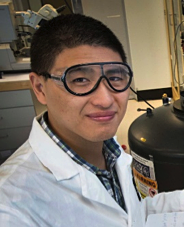 Liusuo Wu
Liusuo Wu
Wednesday, February 4, 2015
Liusuo Wu is a Postdoctoral Associate in Experimental Condensed Matter studying under Meigan Aronson at Stony Brook University. His interests include heavy fermions, frustrated magnets, and neutron scattering experiments.
"Spinon excitations in one dimensional magnet Yb2Pt2Pb"
ABSTRACT: Emergent fractional excitations in low dimensional magnets have attracted great interest in condensed matter physics. Many studies have focused on Heisenberg spin 1/2 systems, where quantum fluctuations are expected to be strongest. Here I will present measurements on a new low dimensional magnet Yb2Pt2Pb, where fractional, quantum spinon excitations are realized from one dimensional ladders with classical Yb Ising moments. Both elastic and inelastic neutron scattering data on Yb2Pt2Pb single crystals will be presented. In contrast to 1D Heisenberg spin 1/2 chains, the broad continuum of excitations observed in Yb2Pt2Pb is extended to much higher energies, indicating four spinon excitations are important in this system.
 Jyotsana Lal
Jyotsana Lal
Monday, February 2, 2015
Dr. Lal is a Researcher at Argonne National Laboratory focusing on the structure and internal dynamics of proteins and coherent diffraction imaging of complex polymer matrices. Her research interests include the development of novel methods for the use of x-rays and neutrons for the study of biological and soft condensed matter materials.
"Polymer chains in confined geometries"
ABSTRACT: Advanced neutron scattering techniques have well elucidated the structure and dynamics of polymer chains in bulk. Much less is known about the structure and dynamics of polymer chains undergoing deformation either mechanical or under shear. An easy way to deform polymer chains is to confine them. In this talk, I will discuss the conformation of single neutral and charged polymers confined in nanopores, also present the case of hydrophobically modified polymers confined to two-dimensional membranes and polymer confined in microemulsion droplets. These experiments depend on the use of techniques that are sensitive to the polymer conformations such as Small Angle Neutron Scattering (SANS) and Neutron Spin Echo (NSE). A brief introduction to neutron scattering techniques will be made. These techniques used by the soft matter community provide fundamental experimental insights into the structure, self-assembly and dynamics of soft materials.
 Zahid Hussain
Zahid Hussain
Thursday, January 29, 2015
Dr. Hussain is one of the 140 most cited physicists. He studies highly correlated electron systems with ultra-high energy and momentum resolution photoemission, resonant inelastic scattering spectroscopy and dynamics with coherent scattering.
"Instrumentation driven science for unraveling emergent phenomena"
ABSTRACT: Sharper and sharper experimental tools are often crucial for understanding of novel physical phenomena and making new discoveries. Today in condensed matter physics we are experiencing need for revolutionary new instrumentation for understanding interplay of many degrees of freedom interacting at different energy, length and time scales. These interactions lead to new phases of matter and emergent phenomena such as high temperature superconductors, topological insulators and thermoelectric materials, to name a few. My talk will focus, through various examples, upon the necessity for advanced techniques and instrumentation to elucidate the basic physics in the arena of soft x-ray synchrotron radiation and free electron laser.
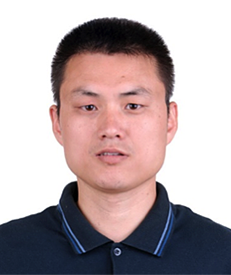 Qiang Zhang
Qiang Zhang
Monday, January 26, 2015
Dr. Zhang is a Postdoctoral Researcher at Ames Laboratory. His research focuses on dielectric, ferroelectric, and multiferroic materials, Fe-based superconductors and complex magnetic materials exhibiting spin glass, magnetocaloric effects, magnetoresistance, exchange bias effects, and spin-orbit couplings, and strongly correlated electron behaviors.
"Magnetism and its coupling to structure and superconductivity in iron pnictides"
ABSTRACT: The discovery of high-temperature superconductivity in the fluorine-doped LaFeAsO has triggered intensive interest in superconductivity and also in itinerant magnetism in general in the "1111" and "122" families of layered iron pnictides. In this talk, I will present the complex magnetic structures in Fe and Ce sublattices determined by the elastic neutron scattering technique in CeFeAsO crystal. We found a spin-reorientation transition of Fe moments prior to long-range ordered Ce moments at lower temperatures, revealing a strong interplay between 4f Ce3+ and 3d Fe2+. The effect of the strong Ce-Fe coupling on the rearrangement of Fe ordering is yet another example of the vulnerability of the Fe spin density wave to perturbations such as minute doping or relatively low applied pressures.
While the previous studies have focused on the impact of superconductivity on the magnetic and orthorhombic phases, the interplay between these two ordered states has been a topic of intense debate and so far lacks a universal picture. Here, I will also present an evidence of sharp enhancement of the spin fluctuations, in particular the spin-spin correlation length below tetragonal-to-orthorhombic structural transition in LaFeAsO and underdoped Ba(Fe1-xCox)2As2 by inelastic neutron scattering measurements, in contrast with what one expects from a typical antiferromagnetic system. Our findings can be consistently described by a model that attributes the structural/nematic transition to magnetic fluctuations, unveils the key role played by nematic order in promoting the long-range stripe antiferromagnetic order in iron pnictides and also indicate the nematicity may help enhancing superconducting temperature in some circumstances in iron pnictides.